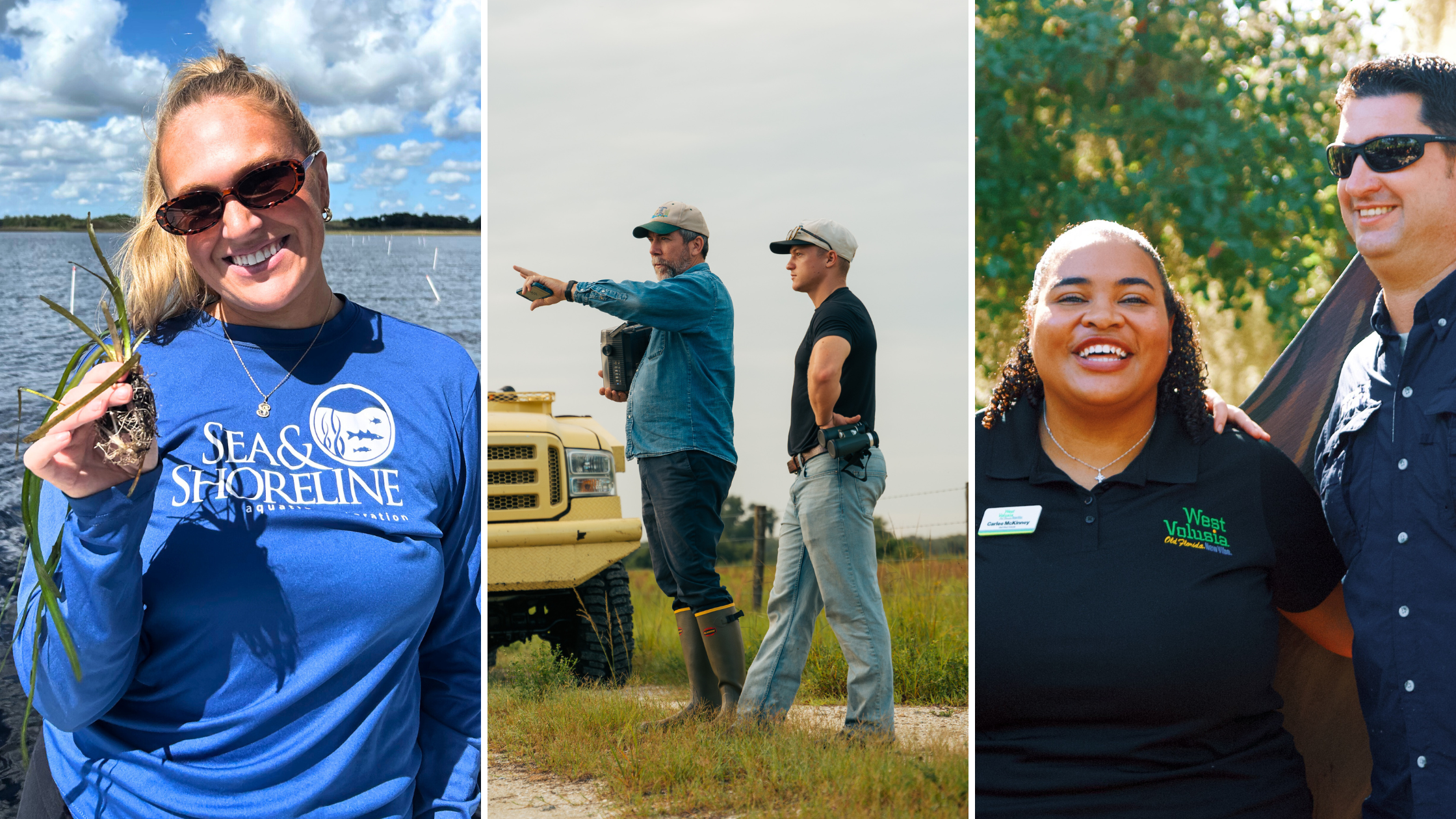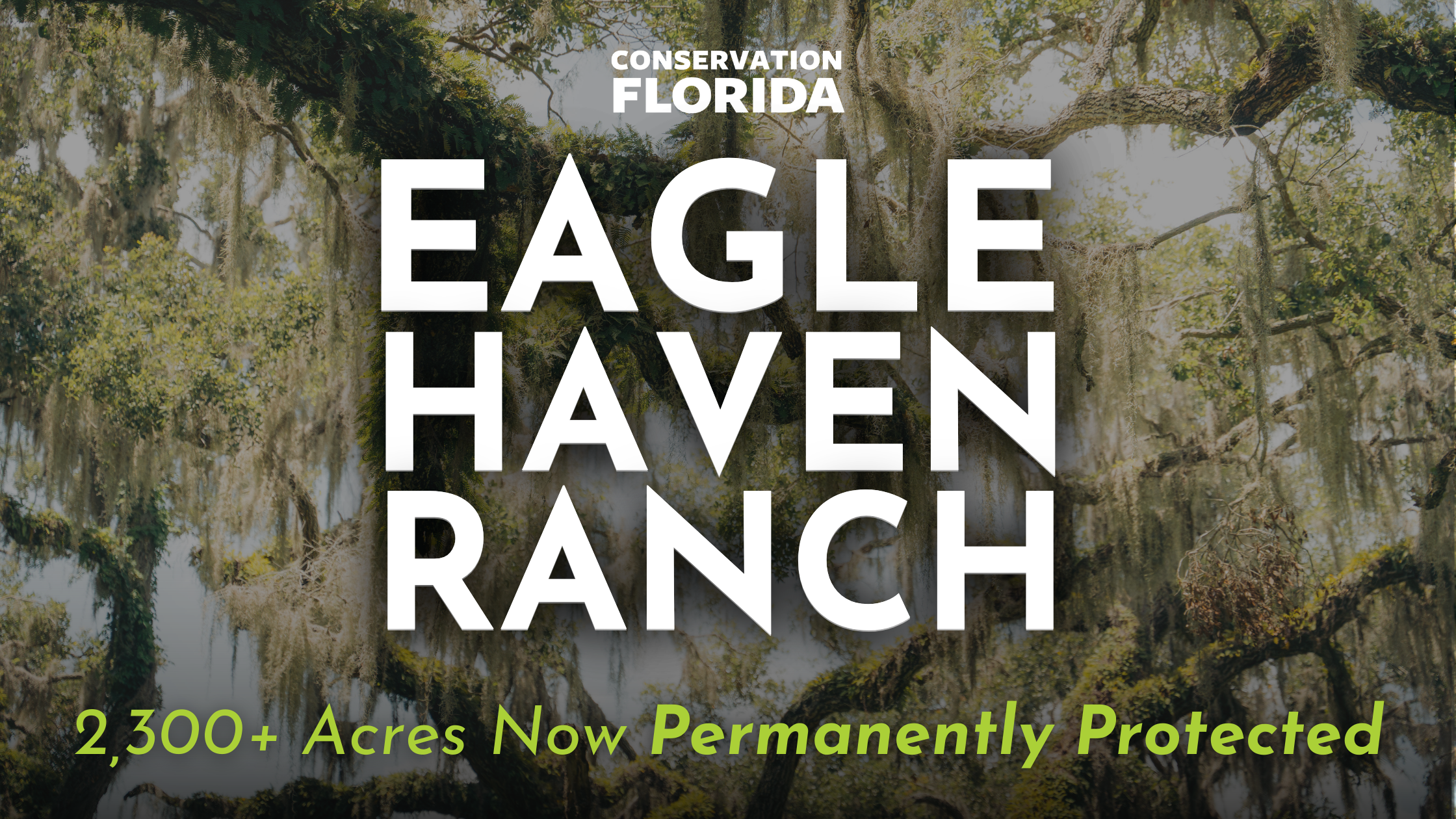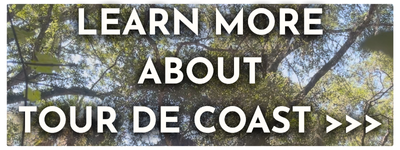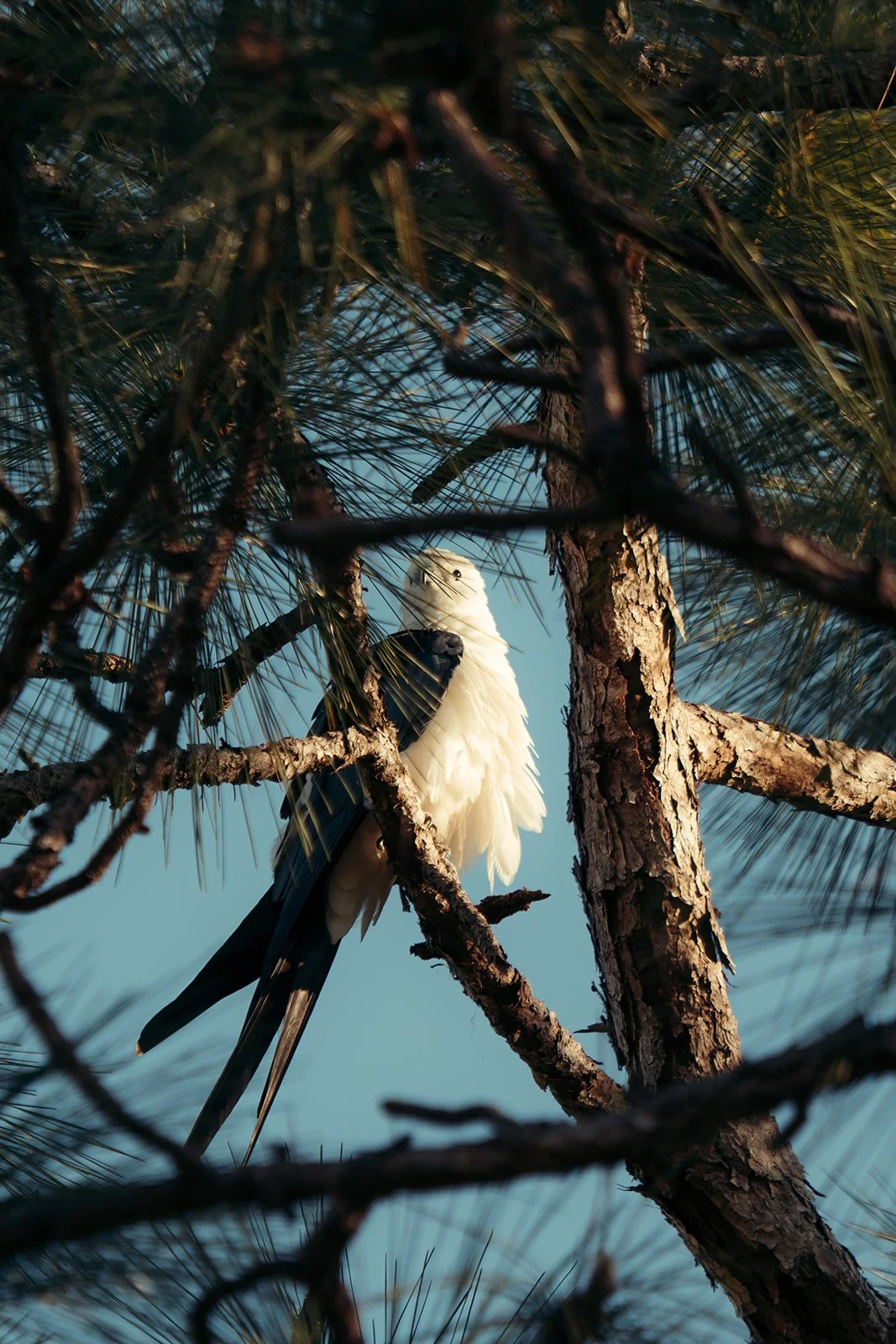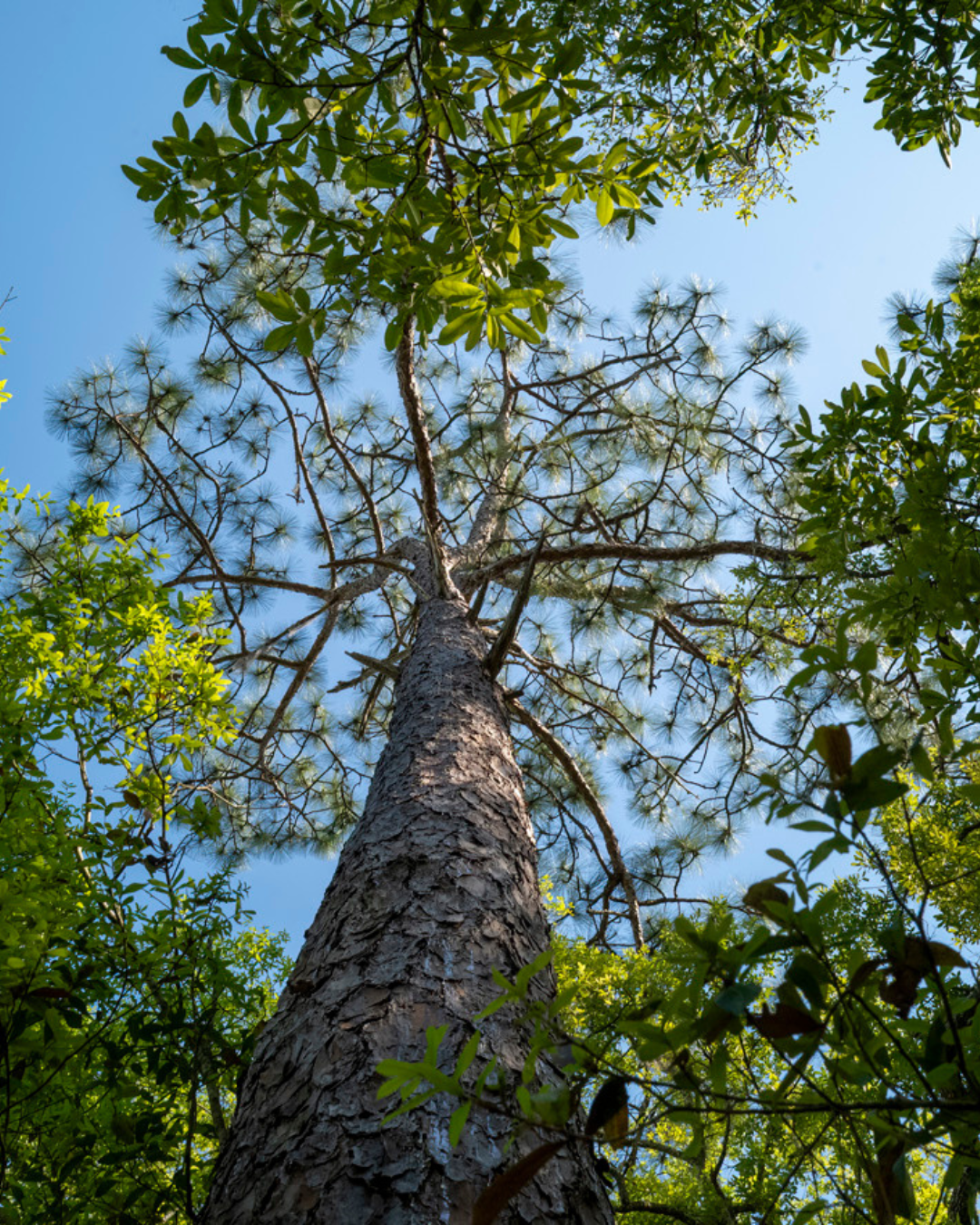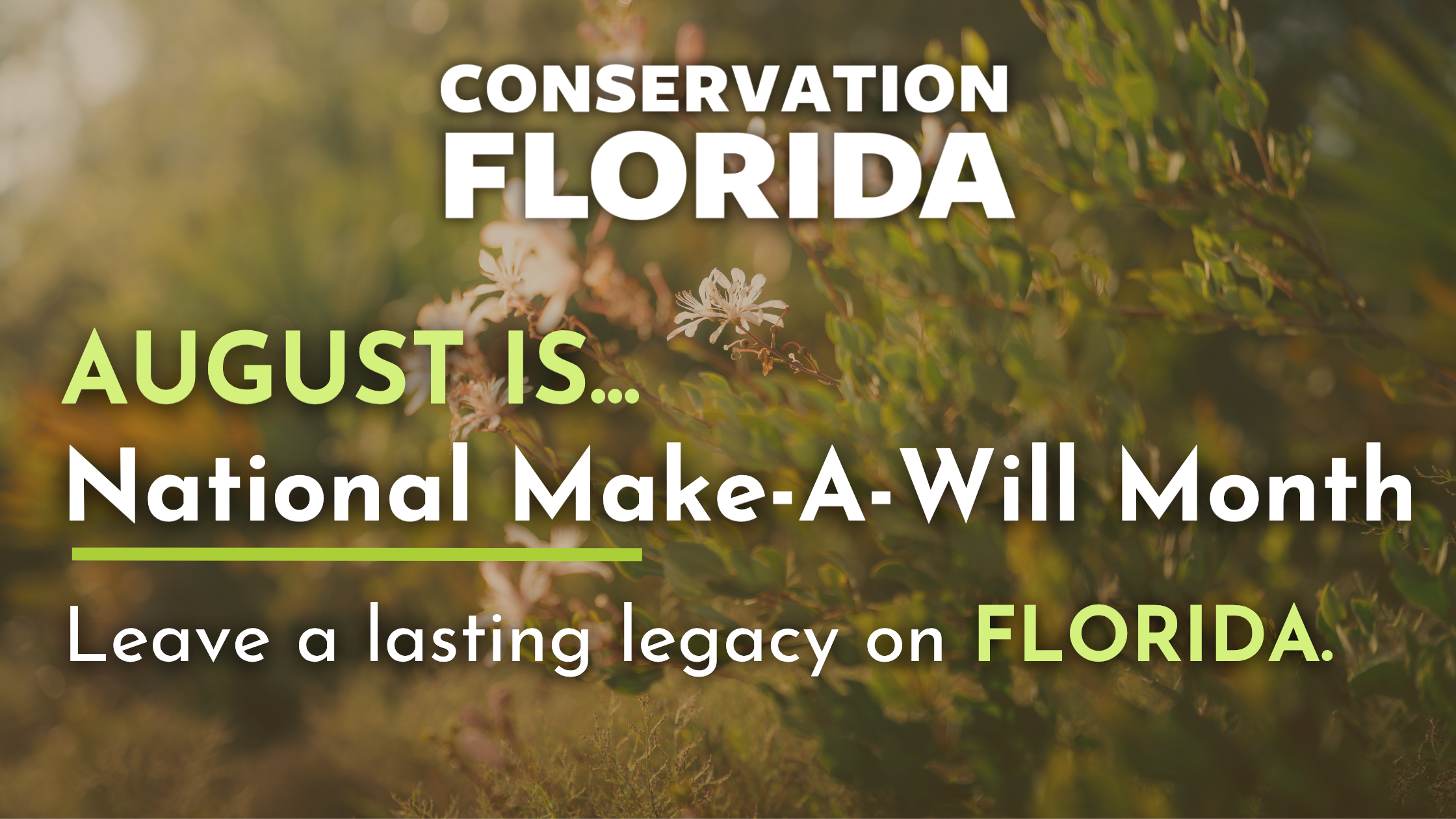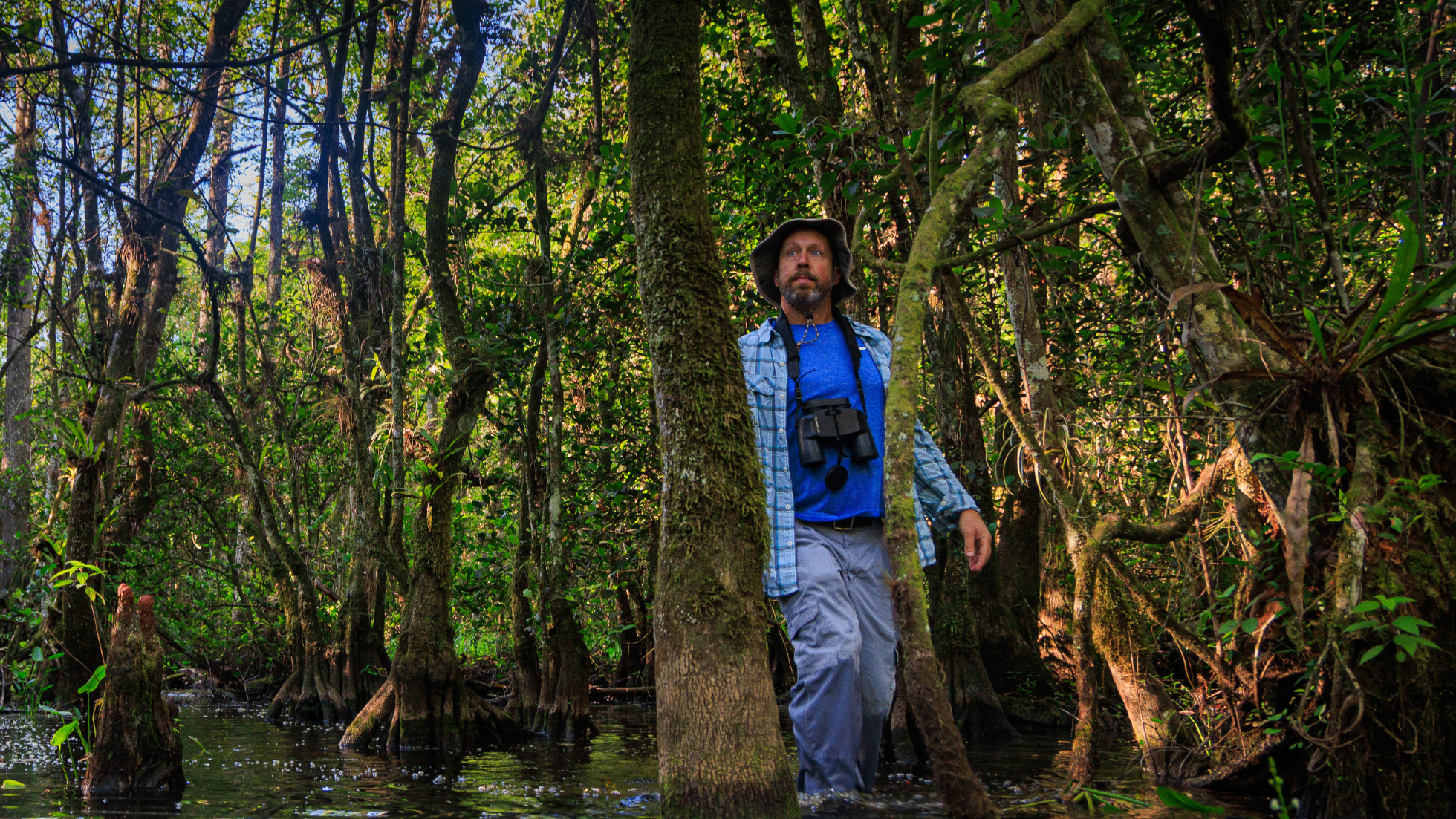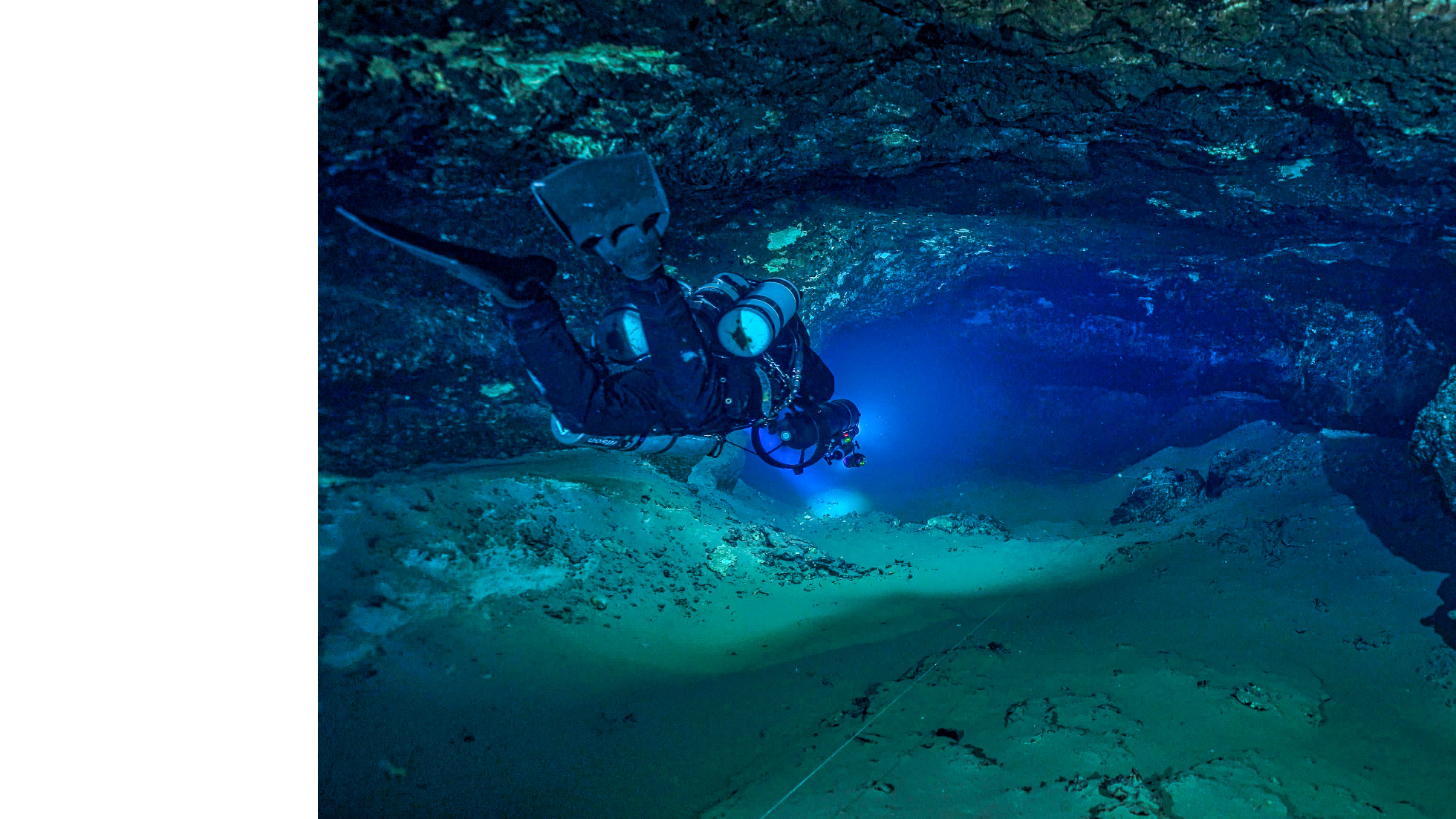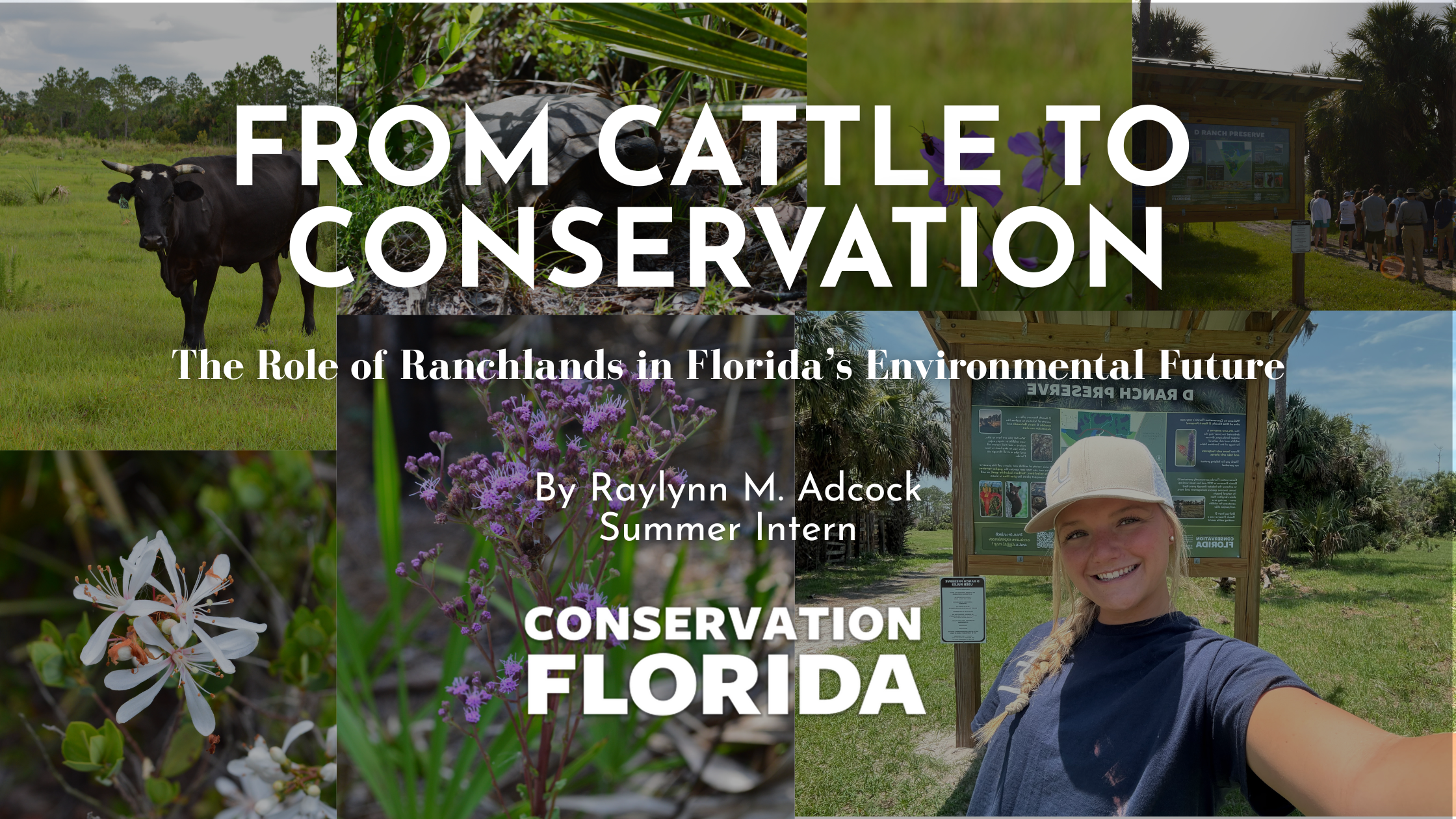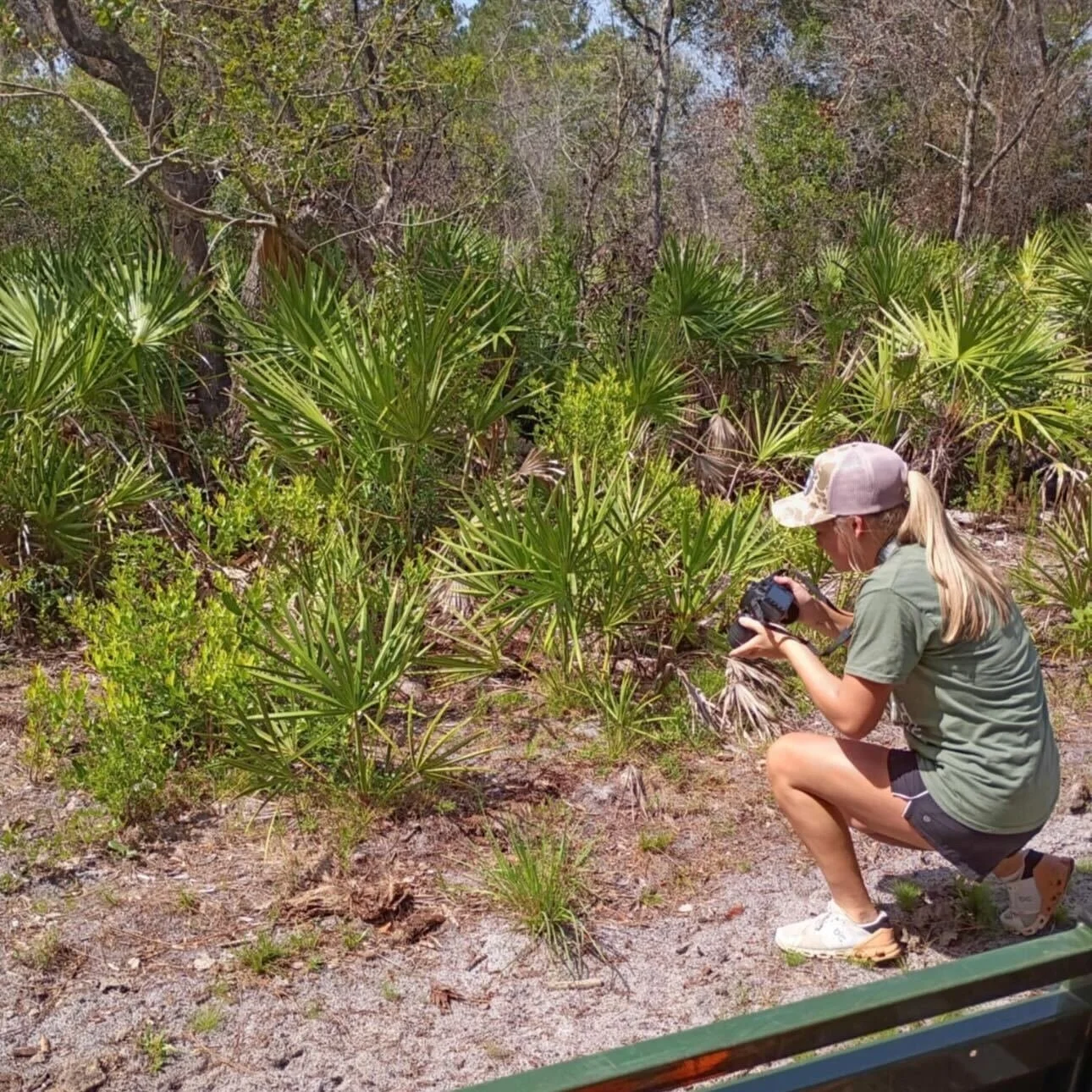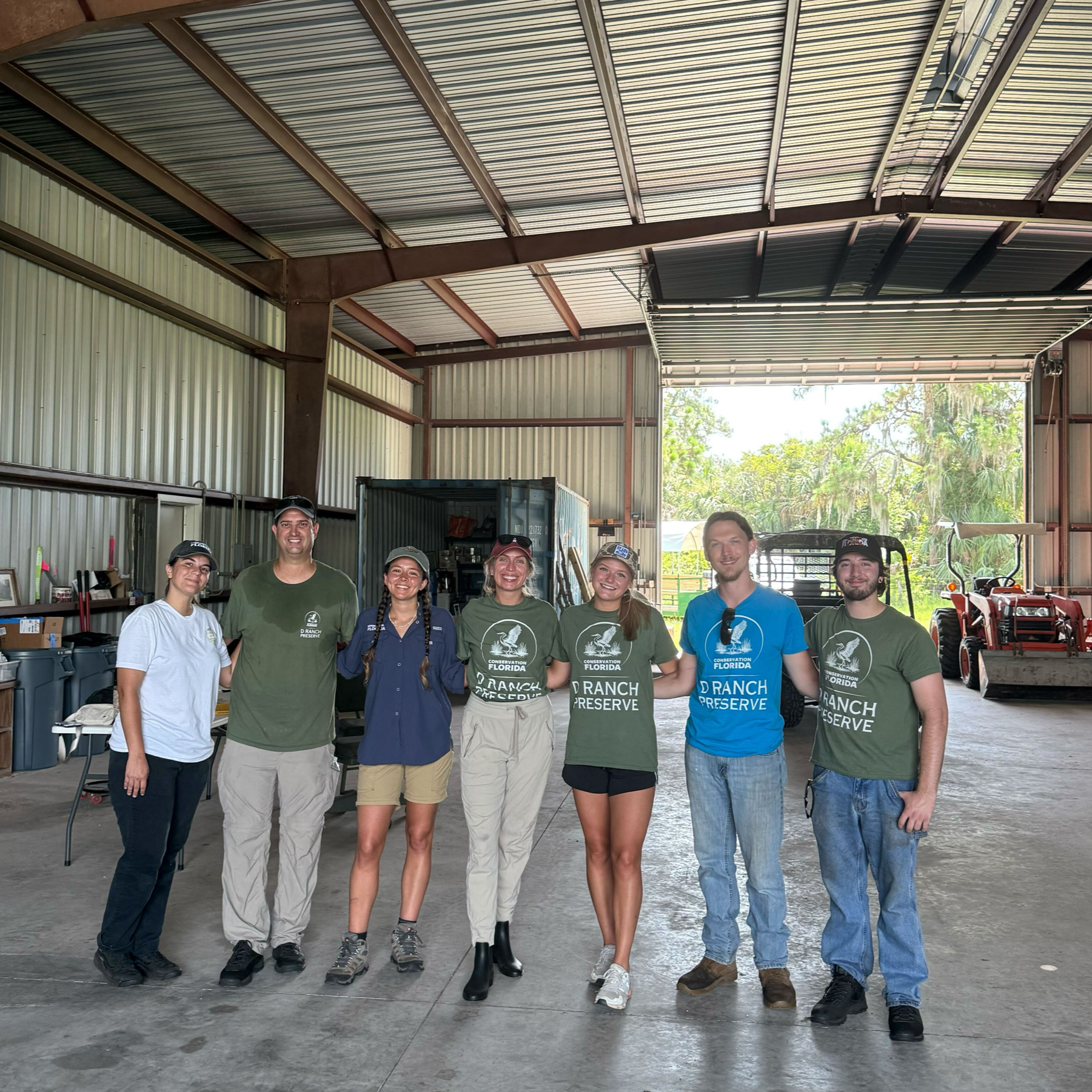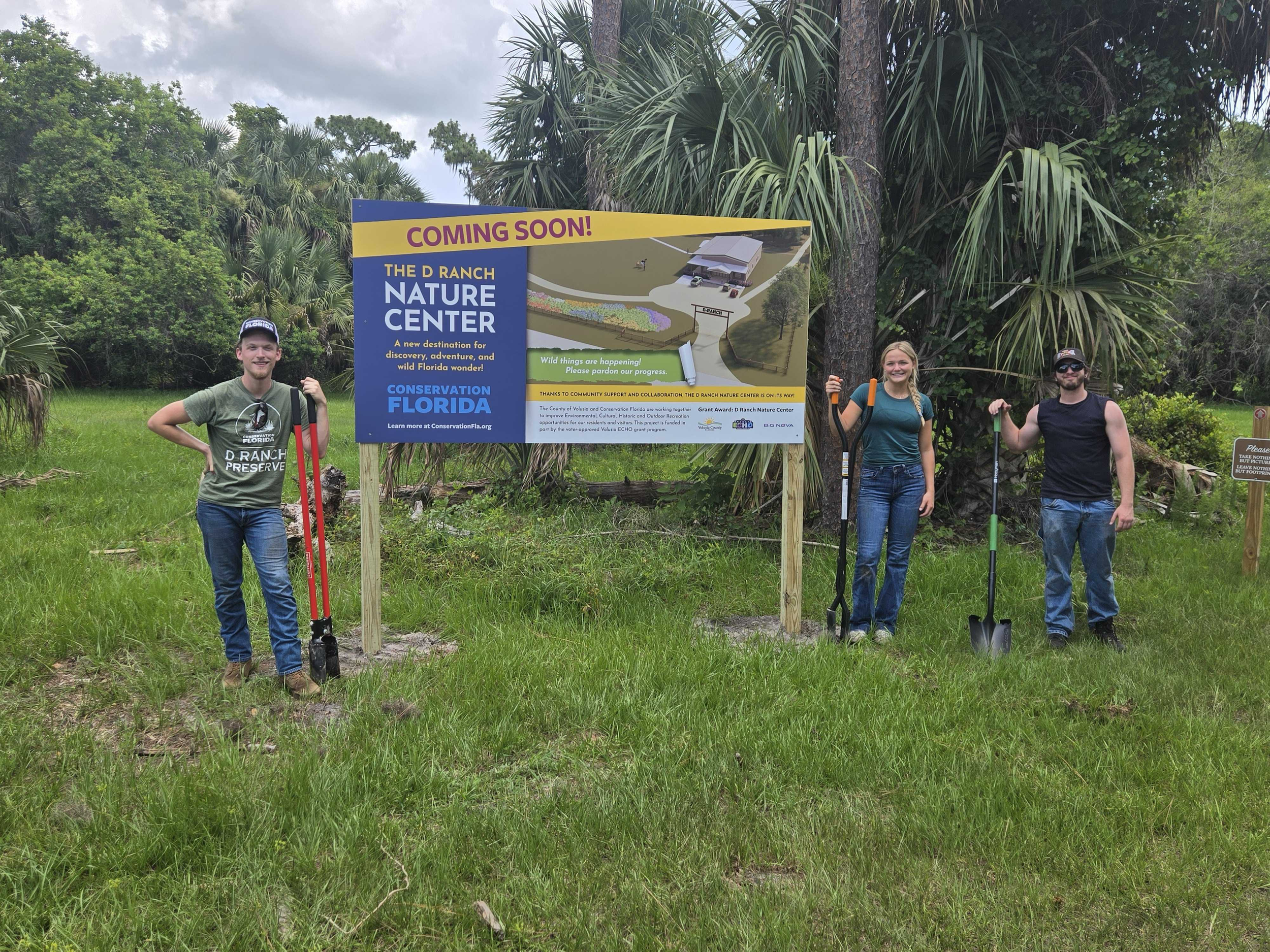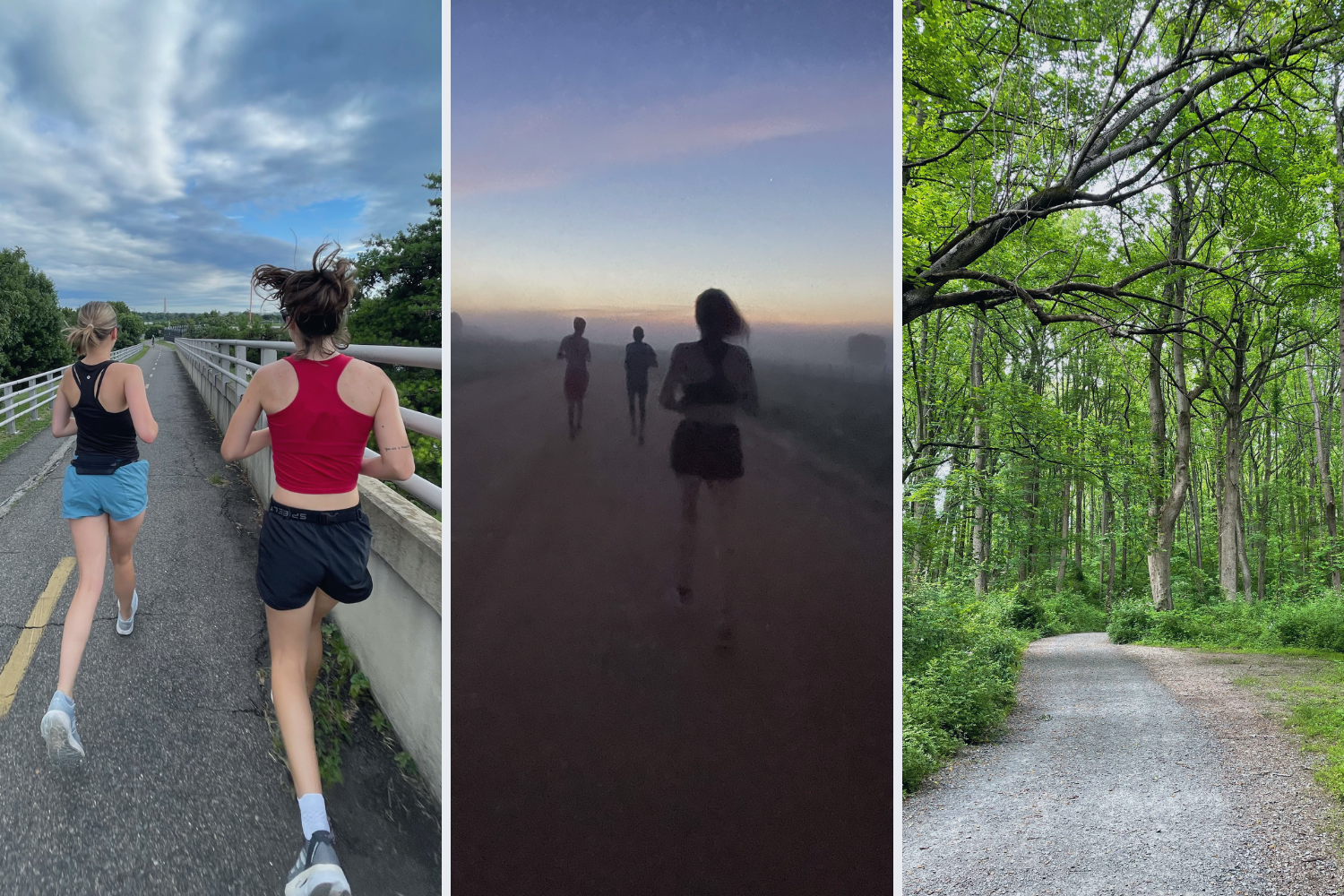Week of Gratitude: Celebrating the People Who Help Protect Wild Florida
With Thanksgiving approaching this week, we’re celebrating the gratitude we feel all year round for our beautiful, one-of-a-kind home … and all those we share it with. Since opening our doors, we’ve now conserved nearly 45,000 acres from Pensacola to the Florida Keys.
But one thing’s for sure: We could not do this conservation work alone.
Protecting the places that make Florida Florida takes all of us. The prairies and pine flatwoods, the winding rivers and beautiful beaches. Room for our prowling panthers and beloved scrub jays.
During our Week of Gratitude, we’re celebrating the people who make this conservation work possible!
To Our Landowners:
You’re leaving the ultimate legacy.
Whether you’re safeguarding working lands, preserving sensitive ecosystems, ensuring wildlife have room to roam, or leaving a legacy for your family, your decision to conserve your property is a gift to all Floridians.
To Our Donors:
You fuel every acre we protect.
Your generosity turns opportunities into real land saved. And not just saved but stewarded forever and safeguarded for future generations. Whether you’ve given once or given annually and joined Club 1845, we’re so grateful.
To Our Volunteers:
You remind us that conservation is a work of heart.
From building trails at D Ranch Preserve to joining bioblitzes at Bellini Preserve to lending your time at community events, you show up. Florida is better because of your commitment, curiosity, and willingness to get a little dirty for a great cause. Thank you for your hard work to care for this place we all love so much.
To Our Partners
Your collaboration multiplies our conservation impact.
Our work is strengthened by incredible partners! From local and statewide governments to foundations, businesses, and fellow nonprofits - none of our permanent conservation work would be possible without the support of our partners. We believe in the power of partnerships. Here’s to many more acres saved!
While Florida is special in too many ways to count, we believe all of you are the very best part. Thank you for your support, big or small, today & every day. We couldn’t do this work without you!
Happy Thanksgiving!
Team Conservation Florida
in case you missed it:
About Conservation Florida:
Conservation Florida is an accredited, nonprofit land conservancy dedicated to conserving the Sunshine State’s water, wildlife, wild places, and connecting a functional Florida Wildlife Corridor. Since its founding in 1999, Conservation Florida has saved more than 40,000 acres, serving all 67 counties in Florida, by prioritizing strategic and evidence-based land protection, education, and advocacy.
Follow us on social media @conservationflorida.
Tour de Coast: Mak’s 550-Mile RIDE for Conservation Florida
All photos provided by Mak
This October, one determined cyclist is taking on the ultimate Florida ride - and she’s doing it for
wild Florida.
Meet Makayla “Mak” Fick, an endurance athlete from Jacksonville Beach who’s trading her daily training rides for a roughly 550-mile, three-day journey from Jacksonville Beach to Key West. Her mission? To raise awareness and funds for Conservation Florida and our work protecting the lands and waters that make Florida home - for people, for nature, forever.
From Her Hello Kitty Bike to 500 Miles
Mak’s love for cycling started early - with the smell of rubber tires, the thrill of speed, and a Hello Kitty bike that she begged her dad to take the training wheels off of. From biking to school every day to outpacing her dad up hills, cycling became more than just transportation - it was joy, challenge, and freedom.
After running at Ole Miss and immersing herself in Jacksonville Beach’s endurance sports community, Mak decided she was ready for her biggest “side quest” yet: Tour de Coast.
Why She’s Riding for Wild Florida
What she’s named the Tour de Coast isn’t just about miles - it’s about mission. Mak was inspired by Conservation Florida’s work to protect Florida’s wildlife corridors, including the Guana River Wildlife Management Area, a critical habitat and recreation area we helped protect from a land swap earlier this year. That victory preserved not just a safe haven for wildlife, but also a beloved route for gravel cyclists and nature lovers alike.
“Cycling has given me so much joy and connection,” Mak says. “I wanted to use this ride to give back - to protect the places I love to explore and help others experience them for years to come.”
Mak’s route across the Sunshine State.
The Ride
From October 24–26, 2025, Mak will pedal the length of Florida in just three days, connecting with local bike shops and fellow cyclists along the way. Each mile she rides will shine a spotlight on Florida’s wildlife corridors - the connected lands that allow animals like the Florida panther, black bear, and countless bird species to roam freely and safely.
“I wanted to use this ride to give back - to protect the places I love to explore and help others experience them for years to come.”
- Mak Fick
How You Can Support Mak’s Mission
Mak has set a fundraising goal to support Conservation Florida’s mission to protect Florida’s wild and working lands. Here’s how you can be part of the Tour de Coast:
Donate to her GoFundMe → Support the Tour de Coast
Follow her journey → Event Details & Updates
Share her story on social media to help spread the word.
Every dollar raised helps us protect the lands and waters that make Florida the paradise we call home.
Together, we can keep Florida wild - for wildlife, for people, and yes, for cyclists!
in case you missed it:
About Conservation Florida:
Conservation Florida is an accredited, nonprofit land conservancy dedicated to conserving the Sunshine State’s water, wildlife, wild places, and connecting a functional Florida Wildlife Corridor. Since its founding in 1999, Conservation Florida has saved more than 40,000 acres, serving all 67 counties in Florida, by prioritizing strategic and evidence-based land protection, education, and advocacy.
Follow us on social media @conservationflorida.
A SAFE PLACE TO LAND
Photos provided by Anna Crocitto, Tim Barker, and Avian Research and Conservation Institute (ARCI)
If you’ve ever looked up on a summer day in Florida and spotted a black-and-white bird with a forked tail gliding effortlessly against the blue sky, chances are you might’ve seen a swallow-tailed kite. These graceful birds, sometimes called “sky angels,” travel thousands of miles each year, chasing warm winds and plentiful food.
You might have even seen a special kite named “Townsend!”
Why so special, you may ask?
This swallow-tailed kite checked in for a stay amongst a pine forest permanently protected by Conservation Florida near Ocala in Central Florida.
You could say he’s pretty close to our hearts.
Townsend is part of a tracking study led by the Avian Research and Conservation Institute (ARCI), which follows these birds on their remarkable journeys to better understand their migration patterns and the habitats they depend on.
Townsend was the last of the GPS-tracked swallow-tailed kites to begin his fall migration. On August 27, he set out on his journey!
He started south from the Savannah River in Georgia, spending his first night along the Altamaha River, a familiar area near his nesting territory.
From Georgia, he continued south to our home state of Florida where he found a peaceful refuge on Conservation Florida-protected land in Marion County - our Millpond Swamp conservation easement.
Townsend’s flight path southward, including a rest at Millpond Swamp.
On Millpond Swamp, he battled no bright streetlights or racing cars. Only the buzzing of bugs and the fresh fog of the morning.
A peaceful moment of his journey south.
For Townsend, Millpond Swamp offered a safe place to rest and refuel. For us, his visit is a reminder of why land conservation matters.
Swallow-tailed kites rely on Florida’s wetlands, forests, and open spaces to find food, raise their young, and safely migrate each year. When we protect those places, we’re not only safeguarding one species; we’re protecting entire ecosystems.
Florida is the stronghold for swallow-tailed kites in the United States. Once nesting in 21 states as far north as Minnesota, their numbers have declined sharply over the last century, with only about 15,000 remaining today. Most now breed here in Florida, making our state essential to the future of the species. By late summer, the young are ready to take flight, and the flocks begin to gather before making their long journey back to South America.
Most swallow-tailED kites now breed here in Florida, making our state essential to the future of the species.
For kites like Townsend, protected wild places aren’t a luxury - they’re a necessity.
Wetlands provide the frogs and insects that sustain them, tall trees offer nesting sites, and large forests give them space to rest before migration. As development and habitat loss continue, conserving these connected, protected spaces becomes even more urgent.
Conservation Florida’s work ensures that birds like Townsend have safe places to land - today, tomorrow, and forever. Through land conservation, we’re helping keep the skies full of these “sky angels.”
When Townsend soared over our protected land, he showed us what’s at stake - and what’s possible when we work together to keep Florida wild.
By September 1, Townsend had reached Cuba, where he stayed for four nights before flying to Cancún, Mexico. He has spent the past few weeks in Mérida, Mexico, and we expect him to continue south to South America soon.
We’ll be looking to the skies next season, hoping to see him again on his journey home.
Thank you to the partners who shared this story with us and are helping swallow-tailed kites like Townsend soar!
American Bird Conservancy (ABC)
The Avian Reconditioning Center for Birds of Prey
Cellular Tracking Technologies CTT GSM-GPS transmitters
Georgia Department of Natural Resources (GADNR)
Microwave Telemetry, Inc. Satellite transmitters
National Fish and Wildlife Federation (NFWF)
Orleans Audubon Society (OAS)
Ornitela GSM-GPS transmitters
PotlachDeltic Corporation
*Swallow-tailed Kites are captured, banded, and fitted with a trackers under State, Federal, and local permits held by the Avian Research and Conservation Institute (ARCI). ARCI partnered with American Bird Conservancy and Orleans Audubon Society to track kites like Townsend through funding from International Paper and the National Fish and Wildlife Federation. More on ARCI’s blog: https://www.arcinst.org/2025/07/17/swallow-tailed-kite-research-coalition-continues-to-improve-sustainable-forests-in-the-southeastern-u-s/
in case you missed it:
About Conservation Florida:
Conservation Florida is an accredited, nonprofit land conservancy dedicated to conserving the Sunshine State’s water, wildlife, wild places, and connecting a functional Florida Wildlife Corridor. Since its founding in 1999, Conservation Florida has saved more than 40,000 acres, serving all 67 counties in Florida, by prioritizing strategic and evidence-based land protection, education, and advocacy.
Follow us on social media @conservationflorida.
Leave Your Legacy: National "Make a Will" Month
We know — writing a will isn’t exactly at the top of anyone’s summer to-do list.
But joining the Florida Land and Legacy Society now will mean a healthier, greener Florida tomorrow.
As we recognize National Make-A-Will Month, we’re inviting you to consider leaving a legacy gift to Conservation Florida. It’s a powerful way to ensure that the wild places you love — the springs, ranchlands, forests, and swamps — continue to thrive long after we’re gone.
And here’s the incredible part:
Every $1 given to Conservation Florida becomes $36 in land protected — thanks to leveraged funding and strategic maneuvering from our team.
Your legacy gift could have an extraordinary impact.
Photo credit: Anna Crocitto
Ways to leave Conservation Florida in your will:
Bequests — Add a simple clause in your will or trust.
Securities — Donate appreciated stocks or mutual funds.
Life Insurance — Name us as a policy beneficiary.
Retirement Plans — List Conservation Florida as a beneficiary on your IRA or 401(k).
Real Estate — Leave land that can be conserved or used to fund protection elsewhere.
Charitable Trusts & Annuities — Create a giving plan that benefits both you and conservation.
No matter your age or assets, there’s a way to leave a lasting impact.
Photo credit: Anna Crocitto
If you have already included Conservation Florida in your estate plans or would like to speak with a member of our philanthropy team about your legacy, please call 352-376-4770 ext. 701 or email at philanthropy@conservationfla.org — we're happy to help.
Together, we can make sure that a century from now, wild Florida is still wild — and still here.
Thank YOU for thinking about the future of this beautiful state we all call home.
in case you missed it:
About Conservation Florida:
Conservation Florida is an accredited, nonprofit land conservancy dedicated to conserving the Sunshine State’s water, wildlife, wild places, and connecting a functional Florida Wildlife Corridor. Since its founding in 1999, Conservation Florida has saved more than 40,000 acres, serving all 67 counties in Florida, by prioritizing strategic and evidence-based land protection, education, and advocacy.
Follow us on social media @conservationflorida.
A Wild Florida Summer Thanks to you!
Because of you, this summer has been
wildly amazing!
From protecting panther habitat to opening new trails, your support turned hot summer days into huge conservation wins.
Mind if we share some highlights?
Here’s just some of what you made possible:
🌿 You helped conserve AP Ranch — 1,003 acres of working lands in Highlands County, home to endangered Florida panthers. This land will remain forever wild, thanks to your support.
🚶♀️ You also helped connect people to the land. In May, we opened 3.5 miles of hiking trails at D Ranch Preserve in Volusia County — a once-private ranch that’s now permanently protected and open for all to explore.
🏆 You helped us tell Florida’s conservation story — and win an Emmy doing it! Our docuseries, Protect Our Paradise, took home a Suncoast Emmy Award, and we couldn’t have done it without you.
🎉 Our Sunshine State Soirée was a sold-out success! Together, we raised over $220,000 to protect Wild Florida. From cocktails to conservation, we celebrated the future we’re building — with you at the center.
Photo credit (left to right): Anna Crocitto, Conservation Florida, Brandon A. Güell
But that’s not all…
💧 You ensured that the largest underground cave system in the United States is protected forever. Chip’s Hole in Wakulla County was saved from development and will now become a preserve for public use and recreation, all thanks to your voices.
🏛️ We took your voice to Tallahassee. At our legislative reception, we brought lawmakers, landowners, and advocates together to champion land conservation and policy that supports protecting wild and working lands.
📝 Our summer interns have been hard at work at D Ranch Preserve — helping restore trails, document wildlife, and support public access. On our blog, intern Raylynn shared a powerful reflection on conservation, connection, and what it means to grow up in Florida.
🐻 Conservation Florida made headlines! News outlets featured our work to give black bears room to roam, highlighting the importance of corridor connectivity and protecting habitat before it's gone.
🌱 And there's more good news: Our Private Lands Stewardship Program is officially serving landowners — empowering Floridians across the state to conserve the places that matter most.
Photo credit (left to right): Carlton Ward Jr., Brandon A. Güell, Chris Werner
And through it all, your impact multiplied. Every $1 you give helps save $36 worth of Wild Florida — protecting more land, more wildlife, and more of what makes this state special. We’re just getting started — and we’re so glad you’re on this journey with us.
Stay cool, and stay wild,
The Conservation Florida Team
in case you missed it:
About Conservation Florida:
Conservation Florida is an accredited, nonprofit land conservancy dedicated to conserving the Sunshine State’s water, wildlife, wild places, and connecting a functional Florida Wildlife Corridor. Since its founding in 1999, Conservation Florida has saved more than 40,000 acres, serving all 67 counties in Florida, by prioritizing strategic and evidence-based land protection, education, and advocacy.
Follow us on social media @conservationflorida.
From Cattle to Conservation: The Role of Ranchlands in Florida’s Environmental Future
by Raylynn M. Adcock, Conservation Florida Summer Intern
When most people picture conservation in Florida, they imagine wetlands, springs, or thick forests, typically not open pastures. As a student at the University of Florida studying animal sciences and agricultural communications, I’ve learned that agricultural lands are more than just farmland. Through my time walking pastures, watching cattle roam, attending events like the Florida Cattlemen’s Convention to talk with ranchers who’ve cared for these spaces for generations, and especially during my internship this summer with Conservation Florida, I’ve seen that these working lands are crucial to Florida’s environment, economy, and way of life.
Until 2019, when D Ranch Preserve was officially protected by Conservation Florida, the land was home to a cow-calf operation. At first glance, D Ranch Preserve may look like any other cattle operation or ranch, but spending time on the land has deepened my understanding of just how much it supports. Working at D Ranch Preserve has shown me firsthand what many already believed to be true: working lands aren't barriers to conservation, they’re the backbone of it. Across Florida, places like D Ranch Preserve are proving that agriculture and conservation can exist not only side by side but in direct support of one another for the betterment of saving wild Florida.
Florida’s ranchlands are more than just grazing space for cattle. They provide vital habitat for wildlife, help keep water clean by soaking it back into the ground, and act as natural buffers against the rapid spread of development. As more houses and highways continue to sprawl across the state, protecting places like D Ranch Preserve feels more pressing than ever.
“Florida’s ranchlands are more than just grazing space for cattle. They provide vital habitat for wildlife, help keep water clean by soaking it back into the ground, and act as natural buffers against the rapid spread of development.”
I’ve witnessed the balance firsthand. Early in the mornings, I see dew fresh on the grass and whitetail deer silently slip through the trees. Nearby, a gopher tortoise disappears into its burrow as a crowd passes it on our guided nature hike. Overhead, sandhill cranes call out in their distinctive voices and their bellowing calls echo through the wide-open sky. As I walk the trails at D Ranch, the smell in the air is a mix of sun-soaked grass and damp earth, leaving me with a warm and earthy feeling of appreciation for the land.
D Ranch sits along a natural path used by many animals to travel safely between ecosystems and fields. It’s like a quiet highway for wildlife, hidden in plain sight. This connection allows animals to roam freely and find food, mates, and shelter essential for their survival. Cattle still graze here too, which adds to the richness of this landscape and reminds us that working lands and conservation lands don’t have to be separate. We’re stronger when we work together, when ranchers, conservationists, and nature itself all play a role in protecting these places.
“Organizations like Conservation Florida work with landowners to protect their land for the future by keeping it natural and undeveloped, while still allowing it to be used for ranching or farming. ”
What stands out to me most about D Ranch Preserve is the way it redefines what conservation can look like. It’s not about taking people off the land or halting production. Instead, it’s about protecting the land’s ability to thrive, even as its role evolves. Organizations like Conservation Florida work with landowners to protect their land for the future by keeping it natural and undeveloped, while still allowing it to be used for ranching or farming. This means families can stay and care for their land, keeping it wild and open for the future.
As I continue learning and gaining experience, I’m more certain than ever that the world we live in today is one in which agriculture and conservation are not only compatible but essential partners. D Ranch Preserve shows what’s possible when we stop seeing these sectors working against one another. At D Ranch Preserve, raising cattle and protecting wildlife are one and the same because here in Florida, agriculture and conservation grow from the same soil. Even more so, the people who work this land are the original conservationists, caring for the soil, water, and animals that depend on it.
If we want to protect Florida’s future, we need to continue working together by listening, learning, and protecting the land that sustains us all.
in case you missed it:
About Conservation Florida:
Conservation Florida is an accredited, nonprofit land conservancy dedicated to conserving the Sunshine State’s water, wildlife, wild places, and connecting a functional Florida Wildlife Corridor. Since its founding in 1999, Conservation Florida has saved more than 40,000 acres, serving all 67 counties in Florida, by prioritizing strategic and evidence-based land protection, education, and advocacy.
Follow us on social media @conservationflorida.
Protect the Land, Preserve the Magic: Spring Awakens
Spring in Florida: New Growth, Lots of Color, and Curious Wildlife
Wild Florida is buzzing with energy. But there’s something you might not know still exists — and it’s truly magical. Keep reading!
All of this seasonal excitement depends on wild, protected land. Without land conservation, these natural wonders face growing threats from habitat loss, fragmentation, and development.
a peek into just some of the excitement spring brings ⬇️
Did You Know Fireflies Still Exist in Florida?
Firefly Nights hosted by Friends of Blue Spring State Park | Photos courtesy of Melissa Gibbs, Professor of Biology at Stetson University
From late winter to early summer, fireflies — yes, lightning bugs! — light up the night in some of Florida’s most undisturbed natural areas. These glowing beetles thrive in healthy intact habitats near water, tall grasses, and trees — far from artificial lights and urban development.
But here's the thing: they need protected lands to survive. We want future generations of Floridians to hear birdsong in the mornings, see panther tracks in the sand, and watch lightning bugs dance at dusk.
Firefly sightings are rare and fleeting, making them one of spring’s most magical treasures. Want to see them for yourself? Check with your local state park or nature preserve to see if they host a firefly viewing event!
Land Conservation Is for Nature and People
Florida — our home — is changing fast. At Conservation Florida, we’re working to keep Florida wild — for the animals, the family farms, and for people like you who love this state. We work statewide every day to protect and connect land, filling in the gaps of the Florida Wildlife Corridor — a vast 18-million-acre network of green space that helps wildlife move, migrate, and survive.
The catch? Not all of that land is protected yet, and we need the help of of our communities to keep land protection a top of mind. It takes all of us.
We’re proud to have protected more than 40,000 acres Florida since 1999. Every $1 spent on land conservation has yielded $36 in conservation impact. That means your gift has been multiplied by a factor of 36! This track record shows that not only are we making a difference for Florida’s native species, but we are also working hard to stretch our resources to protect as much land as possible.
When We Protect Land, We Protect the Joys of Spring
The colors, the sounds, the flashes of light on a spring evening — all of these springtime joys depend on keeping Florida wild. By protecting land, we’re preserving the very essence of spring.
Let’s keep the magic glowing. ✨
in case you missed it:
About Conservation Florida:
Conservation Florida is an accredited, nonprofit land conservancy dedicated to conserving the Sunshine State’s water, wildlife, wild places, and connecting a functional Florida Wildlife Corridor. Since its founding in 1999, Conservation Florida has saved more than 40,000 acres, serving all 67 counties in Florida, by prioritizing strategic and evidence-based land protection, education, and advocacy.
Follow us on social media @conservationflorida.
The Future of Florida Panthers Depends on Conservation
Florida panther captured on trail camera footage by Sean McHugh.
“That was the best day of my life,” said volunteer photographer Brandon A. Güell, recalling an unforgettable morning deep in Fakahatchee Strand Preserve State Park.
It was a cold, crisp morning as the group rode down old, narrow logging roads, touring the newly-added acres to largest state park in Florida -- land permanently protected by Conservation Florida. Surrounded by wetlands, they waded through waist-deep water, spotting snake sheds, ghost orchids, and even Florida minks.
What happened next felt like something out of a Floridian dream.
Just as Conservation Florida’s James said, “We’re right across from one of our parcels,” a feline figure stepped onto the trail ahead — approximately 100 yards away from their side-by-side vehicle.
Scrambling, the group grabbed their cameras and binoculars, barely believing what they saw.
Like most do, they first questioned, “Is that a bobcat?” But as the big cat turned slightly, it became clear. That was no bobcat.
It was an endangered Florida panther. Its distinct tail stretched long behind him — an unmistakable marker of a Florida panther. The beautiful cat turned straight toward them, locking eyes. Its broad head and muscular frame further confirming its identity. Then, as calmly as it had appeared, it walked into the woods, leaving the group stunned.
Florida panther, Puma concolor coryi, photographed by Brandon A. Güell
This extraordinary moment proves that land conservation is working — our rare, native species find refuge in these protected habitats.
A Florida panther spotted near newly protected lands in Fakahatchee Strand Preserve State Park.
Footage by Brandon A. Güell
Strategic Land Conservation is THE Path Forward
Florida panthers are wide-ranging animals that require large, connected tracts of land to hunt, find mates, and raise their young. As overdevelopment continues to fragment their habitat, more panthers are left to search for food and new territory elsewhere – battling busy highways and subdivisions.
The iconic species made headlines last year as they experienced their deadliest year since 2016, with over 30 cats lost. Scientists estimate there are between 120 – 130 left in the wild.
What’s the most effective solution? Land conservation.
Conservation Florida and its many partners are working to connect and protect the Florida WIldlife Corridor, an 18-million-acre network of green spaces spanning the state. The Florida panther's home. For people, a corridor is like a hallway connecting rooms in a house — or, a highway. The Florida Wildlife Corridor functions as a green highway for wildlife. It is an 18-million-acre network of lands spanning the state, but not all these lands are conserved yet. Conservation Florida, along with many other land trusts and conservationists work to permanently connect and protect lands within the Florida Wildlife Corridor – just like the additions to Fakathatchee Strand Preserve State Park.
Map of Conservation Florida’s land conservation projects and the Florida Wildlife Corridor.
Save The Florida Panther Day
The only way Florida panthers will survive in the wild is by protecting the landscapes they need to thrive, their home. Today, on Save the Florida Panther Day, we invite you to be a part of the solution. Support land conservation. Advocate for these iconic cats. Help us keep Florida wild — for the panthers, and for all who call this state home.
Be a guardian of Florida panthers! Donate today, Save the Florida Panther Day, to protect their home!
Share this blog, spread the word, and let your state leaders know conserving the home of the Florida panther is important to you. No act is too small to help protect their home.
About Conservation Florida:
Conservation Florida is an accredited, nonprofit land conservancy dedicated to conserving the Sunshine State’s water, wildlife, wild places, and connecting a functional Florida Wildlife Corridor. Since its founding in 1999, Conservation Florida has saved more than 40,000 acres, serving all 67 counties in Florida, by prioritizing strategic and evidence-based land protection, education, and advocacy.
Follow us on social media @conservationflorida.
Conservation florida celebrates 25 years of strategic land conservation in 2025
Join us for a glimpse into a quarter century of protecting paradise from Pensacola to the Florida Keys. From 1999 to present day, we’ve remained dedicated to Floridians and the places we call home.
From the early vision of our founders in 1999 to our now statewide efforts connecting critical corridors and preserving Florida's most special landscapes, we remain true to what we set out to do all those years ago: keep Florida wild.
The Early Days
Picking up speed
Connecting Corridors
Present Day: More Acres saved than ever before
we’ve spent 25 years…
Fighting for Floridians from coast to coast, saving the lands we all love — from Pensacola to the Florida Keys.
Protecting more than 40,000 acres of Florida’s most diverse and unique landscapes—it all started with just 952 acres conserved.
Connecting communities to wildlife and nature, fostering a shared responsibility for preserving our most special places.
Advocating for landowners and Floridians statewide, championing policies that preserve our natural heritage for future generations.
Thank you, Florida!
Conservation Florida supports the recovery of federally endangered species: Rugel’s Pawpaw
Photo by Erin Paulakovich, Communications Associate, Conservation Florida.
Restoring Rugel’s Pawpaw at Conservation Florida’s Volusia County Nature Preserve: D Ranch Preserve
An eager team gathered at Conservation Florida’s D Ranch Preserve, excited to work in the lush forests of wild Florida and plant something special — Rugel’s pawpaw (Deeringothamnus rugelii). Like the iconic Florida Scrub-Jay, Rugel’s pawpaw is an endemic species. This federally endangered flowering plant, commonly known as Yellow Squirrel Banana, has been found only in Volusia County. As development and fire exclusion has reduced its habitat over the years, local conservation groups are rallying to recover this rare gem through the U.S. Fish and Wildlife Service's Endangered Plant Recovery Plan.
Conservation Florida team members, along with experts from Bok Tower Gardens, Young Bear Environmental (YBE), and the Pawpaw Chapter of the Native Plant Society, worked together to carefully plant over 40 Rugel’s pawpaw in their ideal habitat at D Ranch Preserve. These slow-growing plants thrive in Immokalee soil, which is light in color because it has fewer nutrients. This type of soil is typically found at the edges of mesic flatwoods, where tall pines, low shrubs, and grasses dominate the landscape. Spanning 476 acres, D Ranch Preserve is permanently protected by Conservation Florida. The property's preservation, combined with the right habitat conditions, provides the perfect environment for introducing Rugel’s pawpaw.
Eager for the future of the species, Dr. Norman, Cheryl Peterson, and Danny Young get ready for the exciting activities ahead.
Among the team was Dr. Elaine Norman, professor emerita of biology at Stetson University, whose deep commitment to this species began long before Rugel’s pawpaw was officially listed as endangered in 1986. With her guidance, there was no mistaking the significance of the moment. Each hole dug symbolized the culmination of years of research, dedication, and the hope that future generations will witness this wild, wonderful, and unique species thriving once again throughout Volusia County.
the research doesn’t stop here.
Cheryl Peterson, conservation manager at Bok Tower Gardens, comments, “There’s no seed production in the wild, and we think it’s probably due to a lack of pollinators.”
This planting project is part of a larger recovery plan aimed at buffering the pressures of urban development and habitat loss. Lake Monroe Conservation Area, just across the street from D Ranch Preserve (Google Maps), was a recovery site for Rugel’s pawpaw years ago. Project lead Danny Young of YBE is hopeful that with two sites so close together, pollen transfer can occur, potentially aiding population growth.
D Ranch Preserve is Conservation Florida’s very own piece of paradise — a protected haven for black bears, pine lilies, and now, Rugel’s pawpaw. With over 40,000 acres saved across Florida, our organization works statewide to protect land and collaborate with landowners to implement the best land management practices.
“We’re excited to be a partner in this recovery project and be able to help provide the habitat and management necessary for this endemic species. D Ranch Preserve is an important conservation area providing a home for this species now, along with so many other species.” says Conservation Florida Land Manager Mark Rizzo
The 476 acre property will open its gates in Spring of 2025, offering hiking, scenic outlooks, photography opportunities, wildlife viewing, and more.
FUN FACTS:
Each Rugel’s pawpaw plant at D Ranch Preserve was grown from tissue cultures at Bok Tower Gardens and the Cincinnati Zoo.
Some plants have been growing since 2019, with ages ranging from 1 to 5 years old.
Some plants could bloom as soon as Spring 2025.
Conservation Florida is an accredited, nonprofit land conservancy dedicated to conserving the Sunshine State’s water, wildlife, wild places, and connecting a functional Florida Wildlife Corridor. Since its founding in 1999, Conservation Florida has saved more than 40,000 acres, serving all 67 counties in Florida, by prioritizing strategic and evidence-based land protection, education, and advocacy.
Questions?
Contact Erin Paulakovich, Communications Associate
erinp@conservationfla.org
Struggling to Survive: endangered Florida Panthers Experience Deadliest Year Since 2016, over 30 lost
Rare footage of a male Florida panther recorded caterwauling/calling for a mate. Captured by Sean Mchugh.
All Florida panther footage by Sean McHugh
As their homes vanish, our state animal continues to suffer, with more than 30 Florida panthers lost this year alone. Among the latest deaths is a 7-8 month-old cub in Glades County, tragically struck by a vehicle, followed closely by the death of another male panther in a neighboring county. With vehicle strikes being the deadliest threat to these animals, safeguarding their land is no longer just a priority — it’s a necessity.
The Florida panther is one of the most iconic and endangered creatures in the United States, with only 120 to 230 individuals left in the wild. Every death represents a significant loss to the panther population and further threatens the delicate balance of Florida’s ecosystems.
The Critical Need for Habitat Protection
As development encroaches on their natural habitats, Florida panthers are increasingly at risk. Habitat fragmentation creates a perfect storm of dangers, particularly when roads slice through essential green spaces, leaving panthers to navigate perilous traffic in search of food, mates, and territory.
But there is hope — land conservation and connecting the Florida Wildlife Corridor is crucial to ensuring panthers have a future in Florida. By protecting land and connecting critical habitats, we can reduce the threat of vehicle collisions and provide safe, connected spaces where panthers have room to roam.
As an accredited land trust, Conservation Florida is dedicated to protecting the lands that Florida panthers rely on. Our efforts focus on preserving and expanding these critical habitats by connecting a fully functioning Florida Wildlife Corridor, helping panthers, black bears, and other wildlife thrive for generations to come.
How You Can Help
The survival of the Florida panther depends on actions taken today. You can support land conservation efforts by:
Give a Gift to Protect Their Homes: Safeguard the areas where these incredible animals live, hunt, and raise their young.
Adopt an Acre: Help fund land protection projects to keep wildlife away from roads and ensure their safe passage.
Spread the word: Use your voice to help preserve Florida’s natural beauty and wildlife. Share our mission with your friends, family, and loved ones. No act is too small.
Recent Coverage: Florida Panthers battle habitat fragmentation
Read
Sun Sentinel: Yet another dead Florida panther — this one, crucially, was expanding its range north
WUSF: Florida panthers are dying at a near-record rate this year
Watch the full coverage here.
Act Now to help give panthers a safe passage
We can’t afford to wait — this species depends on the steps we take today. Your support directly impacts the future of the Florida panther, helping us to create and protect the habitat these animals need to survive. Together, we can give these iconic animals a chance to thrive in the wild once again - thrive in their home.
Visit conservationfla.org today to learn more about how you can make a lasting impact on wildlife in Florida.
Help us write the next chapter Florida’s wildlife.
It’s Up to All of Us
Protecting the Florida panther is not just the responsibility of conservationists — it’s something that requires the collective effort of all Floridians. The future of these animals depends on our commitment to preserving the wild spaces they need to survive. From raising awareness to supporting conservation initiatives, every action counts.
Thank you to all the dedicated conservationists, wildlife advocates, and Floridians who are already working to protect the Florida panther and the places they call home. Because it’s their home, too.
Conservation Florida is an accredited, nonprofit land conservancy dedicated to conserving the Sunshine State’s water, wildlife, wild places, and connecting a functional Florida Wildlife Corridor. Since its founding in 1999, Conservation Florida has saved more than 35,000 acres, serving all 67 counties in Florida, by prioritizing strategic and evidence-based land protection, education, and advocacy.
Questions?
Contact Sarah Shepard, Communications Director
sarah@conservationfla.org
to our partners in protection, thank you.
All photos by Anna Crocitto
For almost 25 years, Conservation Florida has been honored to conserve more than 40,000 acres of land — saving vital landscapes that sustain unique ecosystems & wildlife across the state. From the Florida panther roaming the Everglades to the delicate ghost orchid blooming in our swamps, every acre we protect is a step toward preserving the beauty and biodiversity of Wild Florida.
We’ve made strides in our mission to protect Florida’s water, wildlife, and wild places because of you.
It’s your passion, your dedication to wildlife, and your love for the land that fuels our work.
Born in Florida, Bound to Protect
As a South Florida native, Zero Waste Store (ZWS) owner, Sarah Cieslinski, knows firsthand the beauty and fragility of Florida’s natural landscapes. Growing up surrounded by the state’s unique wildlife and precious natural treasures, she developed a deep connection to what’s left of wild Florida.
In 2018, Sarah founded ZWS, an online marketplace offering over 1,000 eco-friendly and plastic-free products from small businesses. Her commitment to Florida goes beyond business — it’s personal, this is her home.
“Florida means everything to me,” Sarah says. “I want to do everything in my power to help protect the wild places we have left.”
As part of the 1% for the Planet program, Zero Waste Store donates a portion of its sales to support Conservation Florida. Their customers have the option to round up their purchases at checkout, directly contributing to Conservation Florida’s land conservation efforts. Allowing customers to stand up for black bears, scrub jays, and all the creatures who call Florida home.
“We may not have physical land to contribute,” Sarah shares, “but I'm happy that our donations help expand Conservation Florida’s land conservancy efforts, which in turn protects Wild Florida.”
When We Stand Together, Wild Florida Can Thrive
Protecting Florida’s water, wildlife, and wild places isn’t something we can do alone — it takes a community that believes in the future of Florida. Every donation, partnership, and act of advocacy has contributed to our mission, and we are deeply grateful for each and every one of you.
You’ve shown up for Wild Florida — for the rivers, forests, and the incredible wildlife — and because of your unwavering support, we are preserving precious green spaces across the Sunshine State.
As Sarah shared, "It makes us feel like we’re a part of the Conservation Florida mission," and that’s exactly what you are: a vital part of this collective effort.
Together, we are building a future where Wild Florida thrives — and we couldn’t do it without you.
Conservation Florida is an accredited, nonprofit land conservancy dedicated to conserving the Sunshine State’s water, wildlife, wild places, and connecting a functional Florida Wildlife Corridor. Since its founding in 1999, Conservation Florida has saved more than 35,000 acres, serving all 67 counties in Florida, by prioritizing strategic and evidence-based land protection, education, and advocacy.
Want to support our land conservation mission?
Contact Sarah Shepard, Communications Director
sarah@conservationfla.org
Every Step Counts: The 2024 Wild Florida 5K raises over $25,000 for land conservation in the sunshine state
Whether you walked, ran, or danced across that finish line, one thing’s for certain: YOU helped save our wild Florida.
Whether you walked, ran, or danced across that finish line, one thing’s for certain: your participation helps ensure our wildlife and wild lands stay exactly that — wild.
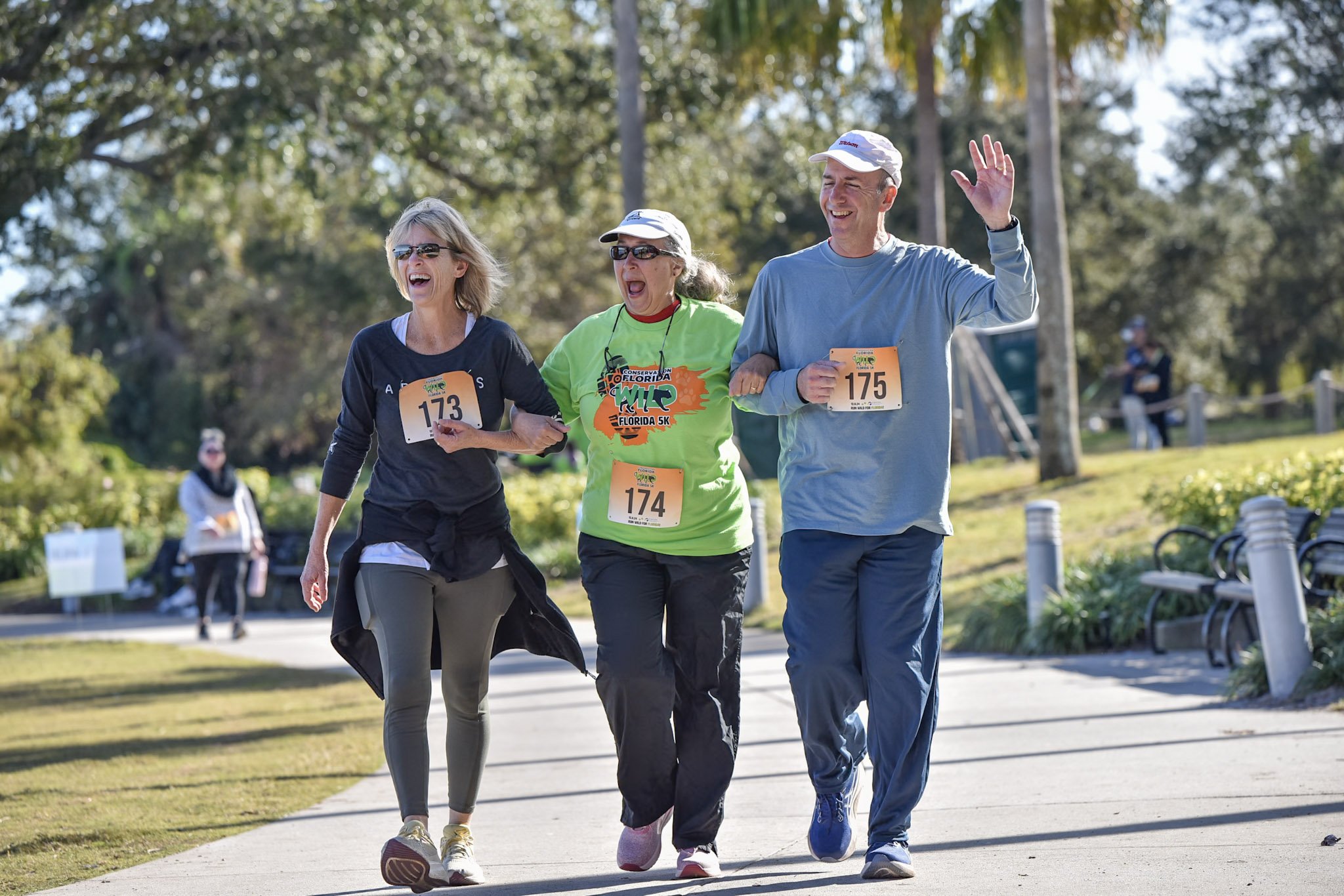
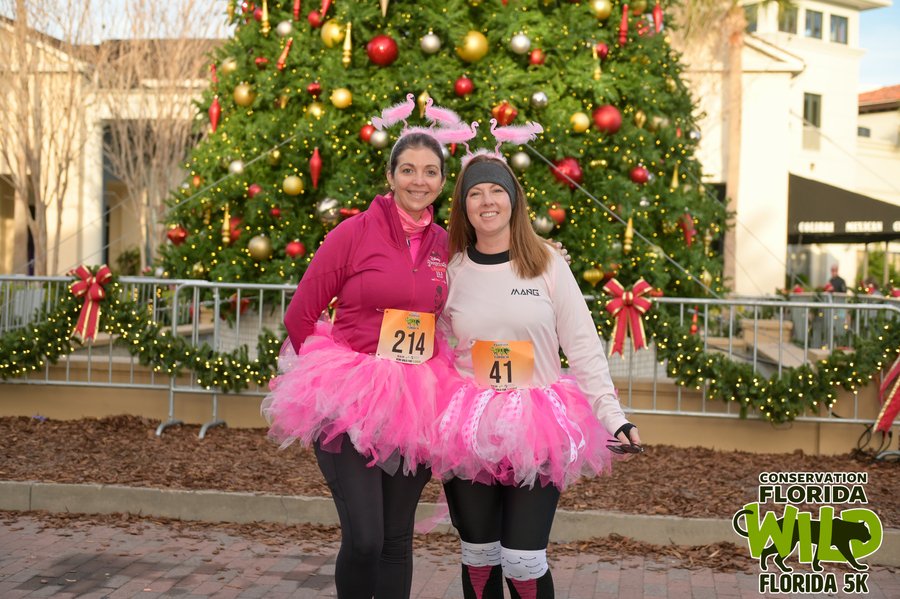

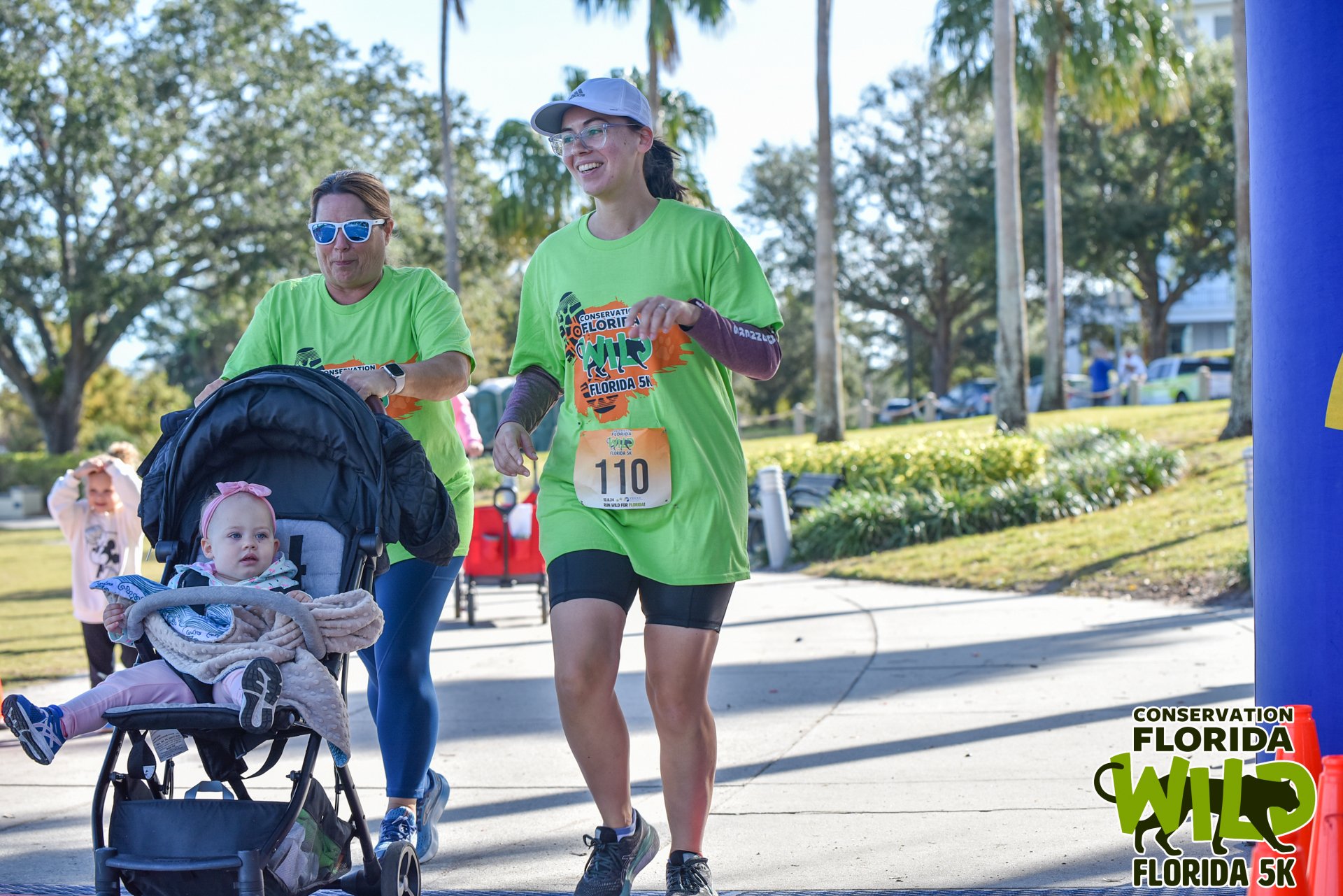
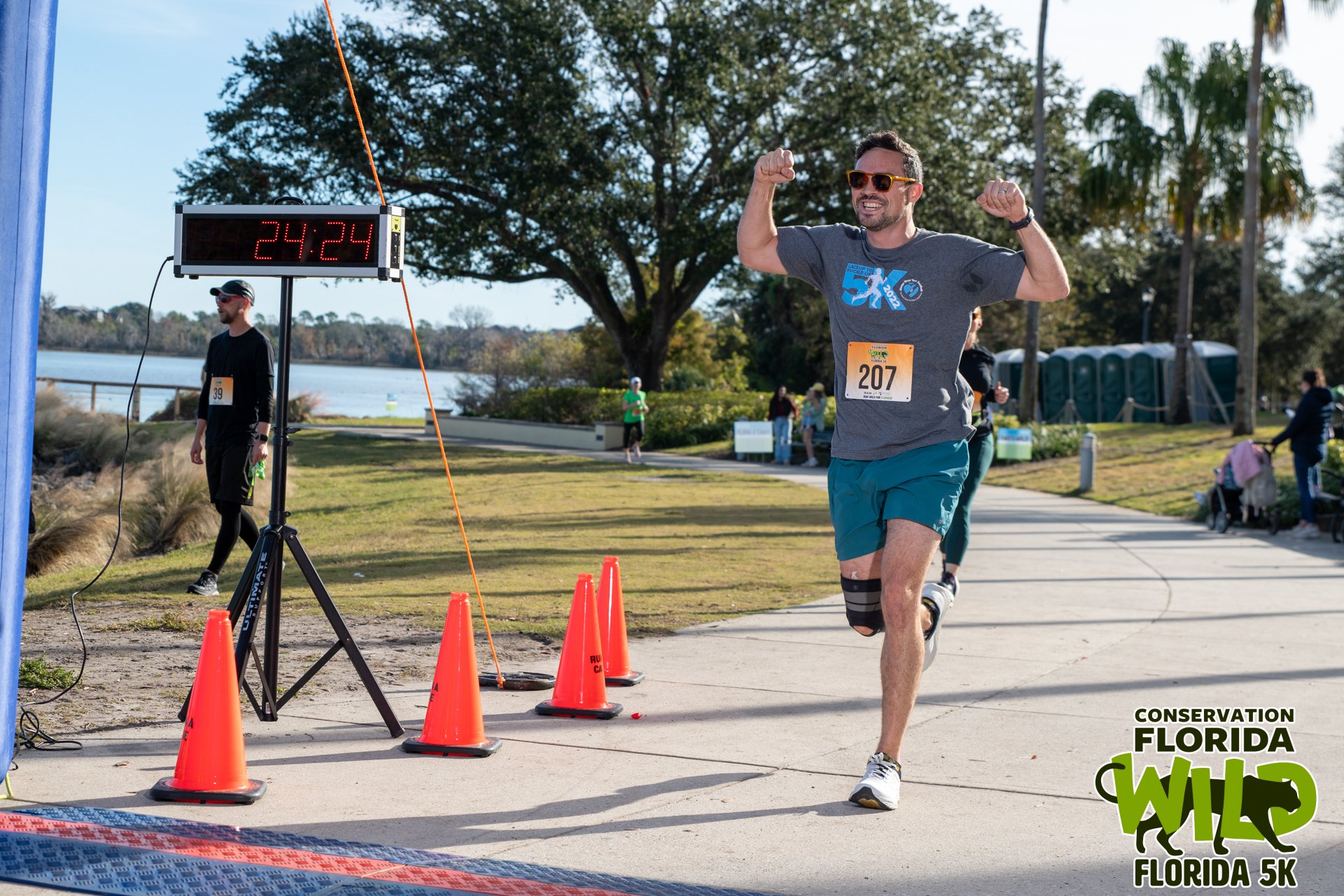
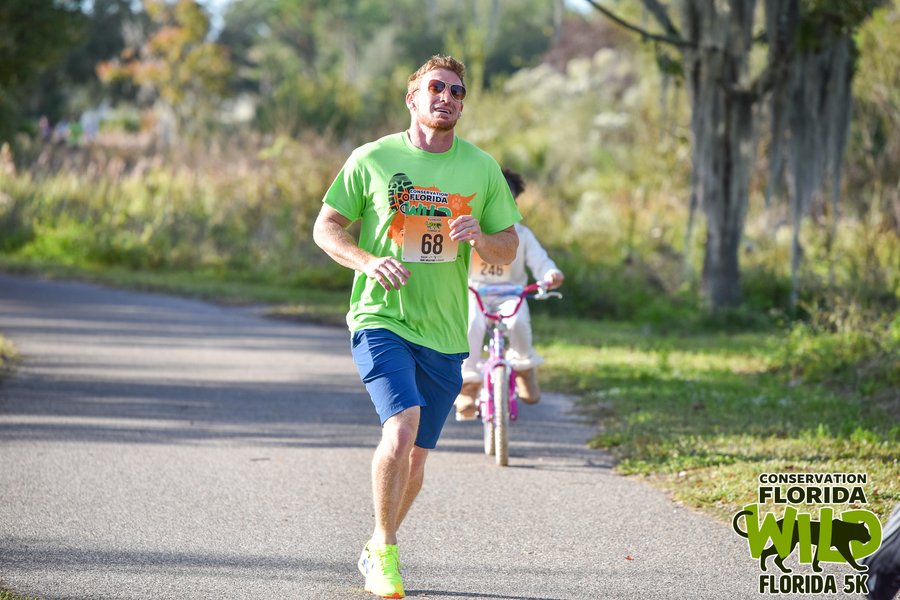
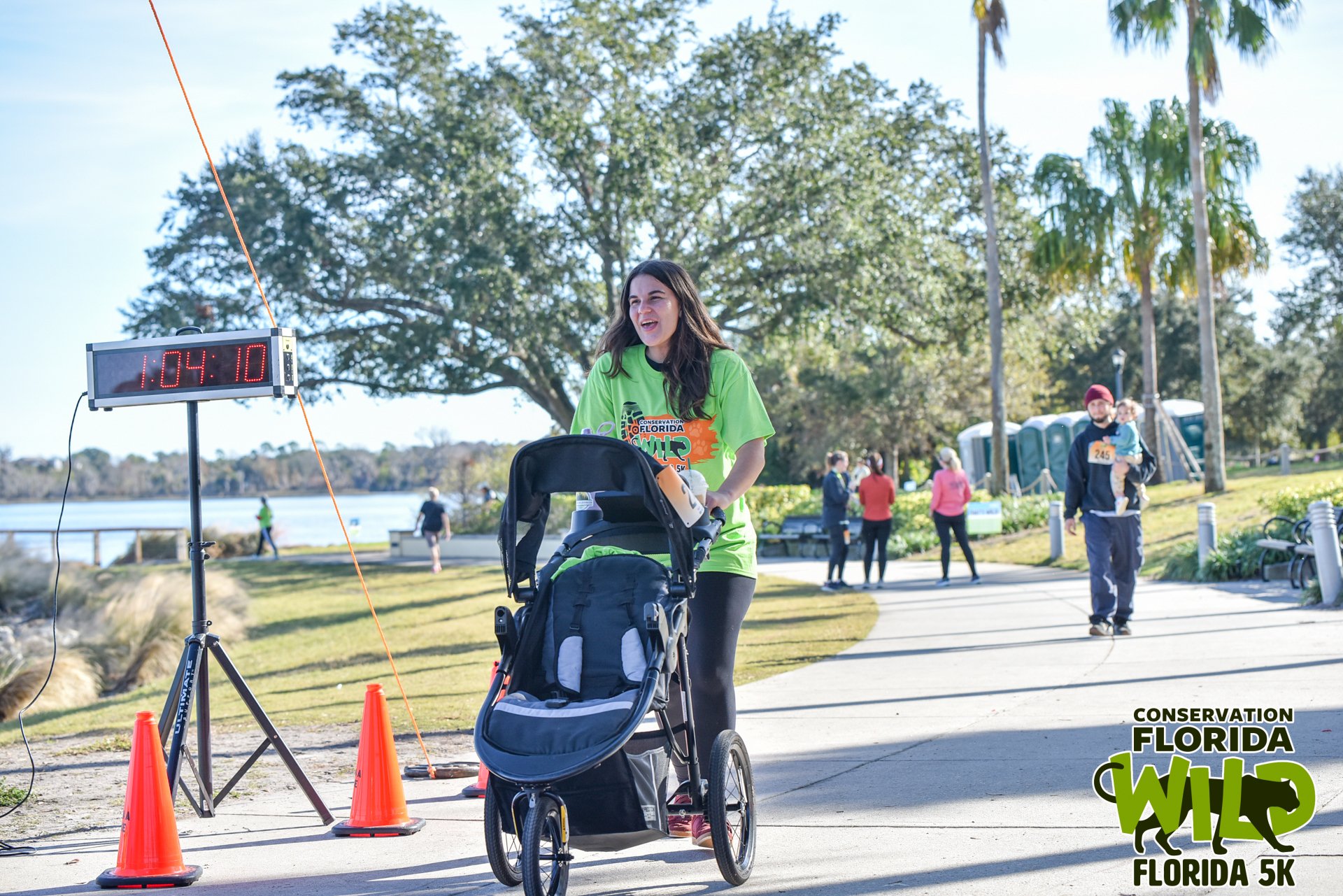
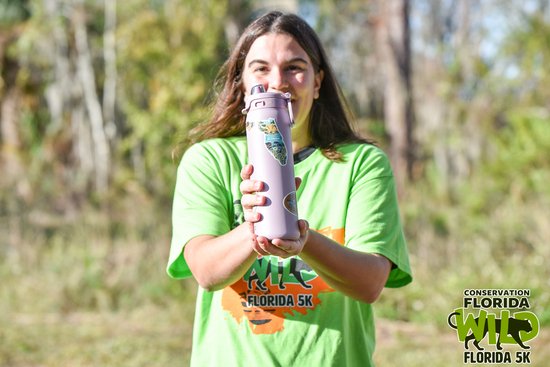
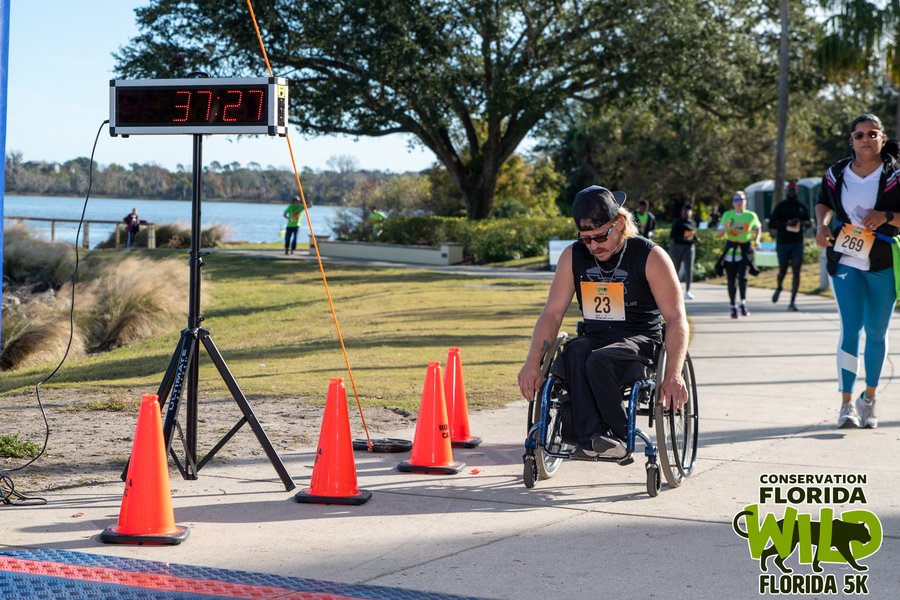
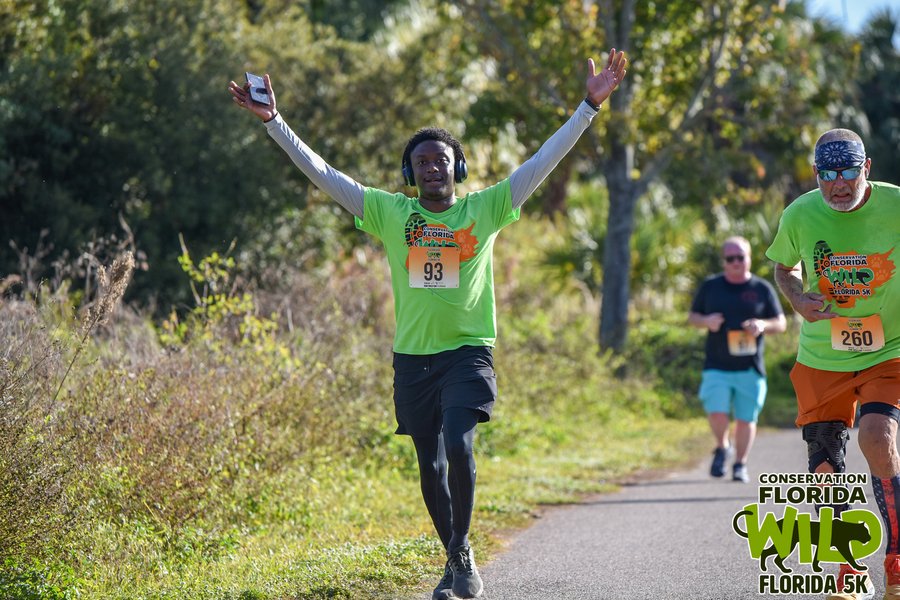
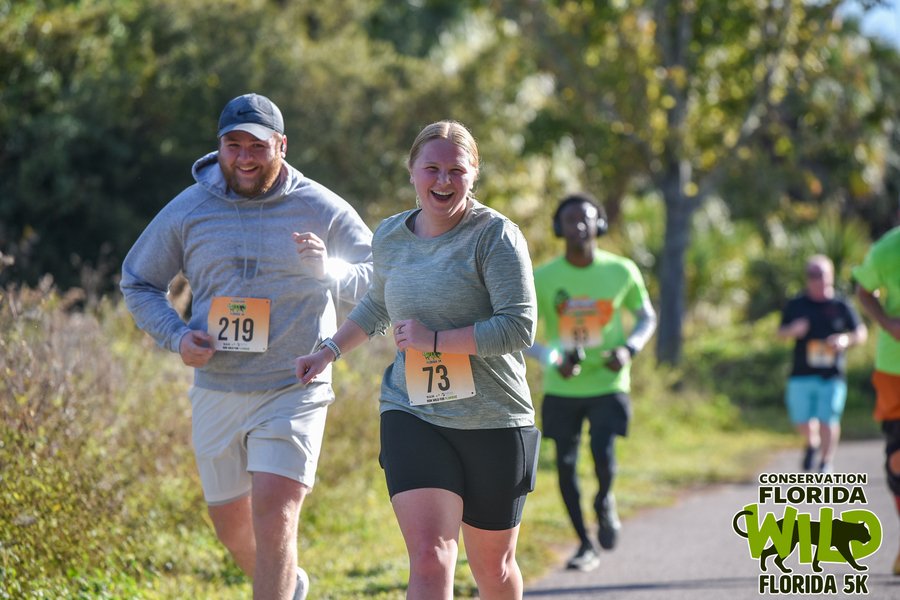
You Made an Impact!
With 425 runners coming out to join us on December 8, 2024, we raised over $25,000 to help protect the lands we love and connect the Florida Wildlife Corridor.
Runners from around the world:
“Living in the Netherlands, just 30 min away from Amsterdam, I was asked to travel to Orlando for my work. I care about nature and try to minimize my carbon footprint where I can. So, anticipating my flight I decided to come a day earlier and find a way to compensate for my environmental impact of the flight. I found your event on the scheduled events for Orlando and it immediately felt the right thing to do.” -Winfried
Runners crushed the course — both in-person & virtually. If you weren’t able to make the event in Orlando, you still made a difference — and broke a sweat!
Click below to view your race day photos! Don't forget to share the fun to social media and tag @conservationflorida!
A big thank you to our prize provider, FLOrigins, who hand-crafted this beautiful Florida flag piece for our overall winner!
Congratulations to our 2024 Wild Florida 5K winners!
THANK YOU TO OUR wonderful SPONSORS!
AND THANK YOU TO OUR EVENT PARTNERS!
Conservation Florida is an accredited, nonprofit land conservancy dedicated to conserving the Sunshine State’s water, wildlife, wild places, and connecting a functional Florida Wildlife Corridor. Since its founding in 1999, Conservation Florida has saved more than 35,000 acres, serving all 67 counties in Florida, by prioritizing strategic and evidence-based land protection, education, and advocacy.
Questions?
Contact Sarah Shepard, Communications Director
sarah@conservationfla.org
Reel Skipper Partners with Conservation Florida for a Cause Close to the Heart: Protecting Paradise
Reel Skipper partners with Conservation Florida to save land. For the month of September, Reel Skipper is donating 30% of proceeds from the Conservation Florida Collection back protecting paradise.
Conservation Florida and Reel Skipper, an adventure clothing brand created by women for women, are teaming up to protect Florida’s wild places! Reel Skipper cares deeply about our planet’s natural wild wonders and all those who care for them. With developers targeting critical habitats across the state, so much we love is at risk. The Conservation Florida Collection aims to support the permanent protection of land that is disappearing rapidly across the state. Reel Skipper is dedicated to supporting Florida land conservation efforts, and you can help, too!
During the month of September, Reel Skipper is donating 30% of proceeds from the Conservation Florida Collection to help fund our mission of protecting the Sunshine State’s water, wildlife, wild places, and permanently connecting the Florida Wildlife Corridor. Purchasing from the collection directly helps protect land.
Conservation Florida has already protected more than 35,000 acres statewide, and with your help, there are only more to come.
Above photos by @anna_crocitto
Do you want to help even more? Getting involved is easy! You can support our mission by sponsoring events, volunteering, starting a fundraiser, donating services, and more! Land conservation is a community effort, and there are numerous ways to give support. Spread our mission and stay up to date by following @conservationflorida.
About Conservation Florida
Conservation Florida is a statewide accredited land conservancy working to conserve Florida’s water, wildlife, wild places, and protect the Florida Wildlife Corridor. The organization’s conservation projects support Florida’s native plants and wildlife, fresh water, wildlife corridors, family farms and ranches, the economy, and nature-based recreation. Since its founding in 1999, Conservation Florida has prioritized strategic and evidence-based land protection and has saved more than 35,000 acres of critical habitat.
Intern Spotlight: Meet Ewan
From volunteer to intern — Ewan’s journey with Conservation Florida began as a service project and blossomed into a deep passion for conservation, ignited by his experiences at the 𝙨𝙩𝙪𝙣𝙣𝙞𝙣𝙜 D Ranch Preserve.
Ewan’s Journey at Conservation Florida
At Conservation Florida, our mission thrives on dedicated and passionate individuals like Ewan, whose journey with us has been nothing short of impactful and inspiring. Ewan first found us through a unique service learning project at University of Central Florida. What started as a school assignment turned into so much more for Ewan. The very values he was studying in our team turned out to be ones he lived by himself, thanks to his experience at D Ranch Preserve, roughly 30 miles outside of Orlando.
From Chance Encounter to Deep Commitment
When Ewan first stepped foot on D Ranch Preserve in October 2023, the sprawling land and the wind through the trees invited him in. He was met by Conservation Florida's land steward, Mark Rizzo, but also by the lush landscape — vibrant greens and earthy browns, where wildlife darted through underbrush and the sky seemed to stretch endlessly. The beauty and potential of the property, combined with the meaningful impact of our work, sparked something within him. He was drawn not only to the hands-on clean-ups but also to the broader mission of Conservation Florida. His semester-long project soon turned into an ongoing involvement, driven by a newfound passion for conservation and the unique charm of D Ranch Preserve.
Why Ewan Chose to Return
Ewan's connection to D Ranch Preserve grew stronger with each visit. Living in bustling Orlando, he cherished his escapes to the serene expanse of D Ranch Preserve. Each visit was truly wild: the brisk, fresh air that invigorated him, the dramatic thunderstorms that rolled across the horizon, and the subtle rustling of creatures hidden in the tall grass. These moments — watching a deer cautiously approach a clearing or feeling the first droplets of rain after a dry spell — cemented his belief in the importance of preserving such spaces. The ranch wasn’t just a piece of property; it was a testament to nature's resilience and a beacon for his future aspirations.
Making a Difference Together
Through early mornings and hands-on learning, Ewan's commitment landed him an internship. Mornings at D Ranch Preserve were a mix of grit and discovery: the challenge of treating invasive Cogan grass and the quiet satisfaction of seeing the land thrive. Under Mark’s mentorship, Ewan gained invaluable skills — balancing multiple projects, understanding land management, and witnessing the tangible effects of their work. Each skill learned was another brushstroke on his growing canvas of conservation knowledge.
“Every time I'm out there, I'm learning something new.”
Reflecting on the Experience
Working with Mark has been a highlight for Ewan, who praises the mentorship and practical skills he’s gained. Whether it's tackling trail maintenance or listening in on strategic planning sessions, Ewan values the broad knowledge and skills he's developed. He recalls the feeling of working on the ranch, reinforcing his desire to pursue a career in conservation. "To think that this kind of work could be a career path is so uplifting and inspiring. This is what I want to be doing, this kind of work,” he says.
Join Us in Our Mission
Ewan’s journey embodies what makes Conservation Florida special. His enthusiasm is infectious.
“It’s amazing to see people’s faces light up when they hear about D Ranch,” he says with a smile.
We invite you to experience the magic of D Ranch for yourself — explore the trails, feel the pulse of the land, and see how you can contribute to our mission. From community outreach to trail planning events, there’s a place for everyone to make a meaningful impact. Join us, and be part of something extraordinary.
“Ewan is a great example of how passion, leadership and volunteerism can lead to further contributions in conservation,” said Conservation Florida Land Steward Mark Rizzo.
About Conservation Florida
Conservation Florida is a statewide accredited land conservancy working to conserve Florida’s water, wildlife, wild places, and protect the Florida Wildlife Corridor. The organization’s conservation projects support Florida’s native plants and wildlife, fresh water, wildlife corridors, family farms and ranches, the economy, and nature-based recreation. Since its founding in 1999, Conservation Florida has prioritized strategic and evidence-based land protection and has saved more than 35,000 acres of critical habitat.
Save the Florida Panther Day: March 16, 2024
Save the Florida Panther Day, is a day — recognized by Florida law — to show some love for our state's iconic big cat. Because Florida isn’t just our home — it’s theirs, too!
Photo by Adam Bass, Vice President of Conservation
A Call for Conservation
Today, Save the Florida Panther Day, is a day — recognized by Florida law — to show some love for our state's iconic big cat. Because Florida isn’t just our home — it’s theirs, too!
Florida panthers once sprawled all across the Sunshine State — even roaming as far west as Arkansas and as far north as South Carolina.
Today only about 120-230 adult panthers exist, and they’re primarily spotted only in southwest Florida.
At Conservation Florida, we're committed to safeguarding the Florida panther's habitat. Last year, we preserved more than 10,000 acres within the Florida Wildlife Corridor, ensuring safe spaces for these majestic cats to roam and thrive.
A male Florida panther’s territory can span 200 to 250 square miles in size. With roughly 1,000 people moving to the state each day (that’s a city the size of Orlando every year), their home is at risk.
The Florida panther was added to the endangered species list in 1967.
Male panthers typically weigh between 100 and 160 pounds, while females weigh between 70 and 100 pounds.
In the Seminole language, the panther is known as coo-wah-chobee, which means "big cat."
Florida panthers often have a distinctive right-angle kink at the end of their tails.
Panthers in the wild can live for 20 years or more.
Florida panthers are an umbrella species, which means when we protect panthers, we protect other threatened and endangered wildlife.
One of the greatest challenges facing the Florida panther is mortality due to collisions with vehicles. As development continues to encroach on panther habitat, the number of roadkills remains a significant concern.
In 2023 alone, there were 13 documented panther deaths, and all of them were attributed to vehicle collisions. These losses highlight the urgent need for measures to reduce wildlife-vehicle collisions and protect panther habitats.
You may have seen wild news stories of Florida panther sightings while on an evening neighborhood stroll — or even in your own backyard. It may seem exciting — the elusive Florida panther! But these big cats are simply on the hunt for territory to call home.
At Conservation Florida, we work tirelessly to ensure the Florida panther has room to roam — a home.
Our land protection projects have directly impacted the conservation of the Florida panther, ensuring populations continue to grow and thrive.
When you support Conservation Florida, you’re protecting the Florida panther, ensuring the survival of this iconic, endangered species.
Conservation Florida to Host Inaugural Sunshine State Soirée
We are thrilled to cordially invite you to the Sunshine State Soirée, promising an unforgettable journey from the bustling streets of metropolitan Orlando to the untamed beauty of wild Florida. Leave the city behind without actually leaving it.
Join us on Friday, April 5th, and trade the concrete jungle for sprawling swamps and buzzing wildlife. It’s an evening to celebrate what we all love — the real Florida.
Join us on Friday, April 5, and trade the concrete jungle for sprawling swamps and buzzing wildlife.
We are thrilled to cordially invite you to the Sunshine State Soirée, promising an unforgettable journey from the bustling streets of metropolitan Orlando to the untamed beauty of wild Florida. Leave the city behind without actually leaving it.
Join us on Friday, April 5th, 2024, and trade the concrete jungle for sprawling swamps and buzzing wildlife. It’s an evening to celebrate what we all love — the real Florida.
📆: April 5, 2024
⏰: 6 p.m.
Purchase your tickets now and secure your spot at the Sunshine State Soirée.
Sponsorship opportunities are also available, providing a unique chance to showcase your commitment to conservation.
Your participation directly contributes to safeguarding Florida's natural beauty for generations to come.
By attending this special event, you’ll not only have the opportunity to experience the awe-inspiring beauty of our home but also play a vital role in saving it. .
From captivating décor inspired by the diverse ecosystems of Florida to exquisite cuisine showcasing local flavors, every element of the soirée is designed to feel like home — to feel like Florida.
Proceeds from the Sunshine State Soirée go directly back to Conservation Florida’s work to conserve Florida’s natural & agricultural lands — from Pensacola to the Florida Keys.
Contact Allison@conservationfla.org for details.
Conservation Conversations with Erin Klein: Running the Path to Protection
With the new year often comes new goals & new resolutions (whether they’re self-motivated or culturally conditioned, we don’t judge). For many, that involves new hobbies — maybe even some extra exercise here and there.
Check out Erin’s take on it all! You might just find yourself running on the path to protecting wild Florida.
A Conservation Conversation with Erin Klein, Conservation Florida Intern
Why wild Florida? Why protect it?
I began running when I was twelve.
My dad invited me to run with his Navy friends along the Tampa Riverwalk, convincing me despite my raging reluctance and apprehension. Underneath the blazing Florida sun, my lungs burned, on fire from exertion. They weren’t used to this sort of stuff.
I remember wanting to give up and walk but pushing myself to finish the run. That feeling of exhilaration at the end was something that I would not forget. I did that!
Soon, I began to look forward to these runs, not only because of that elusive “runner’s high” that I’d chase, but because of the wildlife that would accompany me on new trails and pathways — the seagulls flying overhead, a snake here and there, and dolphins popping out of the sparkling sea.
I was hooked — I needed to see more.
Next, I was running through the marshes of the Dyke Marsh Wildlife Preserve, alongside the Potomac River, my favorite trail in Alexandria, Virginia. One of the reasons I love it is because you can look across the river to see the National Harbor in Maryland. If you really wanted to, you could run all the way to the National Mall in DC. That was more than a few miles, though.
Most of all, I loved the greenery that enveloped me as I ran through the preserve. As I was running through the foliage, it felt like I could release my worries and stressors to the leaves and dirt surrounding me.
I was able to let it all go.
There are few places that bring me the level of serenity that nature does.
Moving to Gainesville solidified my love of running in nature — along with it, my innate desire to protect it.
I arrived on the University of Florida campus anxious at the thought of being on my own for the first time in my entire life. Being away from my safety net — my family and friends and the familiarity of life in Virginia — was terrifying. Growing up as a military child, this was not a new experience, but this didn’t make this move any easier.
I decided to bank on the one source of consistency that I knew I always could — nature. I Googled the closest running trail, the Hawthorne Trail, and set off.
As soon as I stepped out of my car, feet solidly on soft soil, I finally drew in a real, deep breath. I was at last alone, away from the hustle and bustle of campus.
But I wasn’t really alone, was I?
Birds flew overhead, and I listened to their twinkling. I saw squirrels running about along the foliage and then up the trees. I ran off the trail at one point to explore the stream below and came across small turtles sitting on the logs around it, soaking up the sun. A couple of miles down the path, I came across a sign labeled “Payne’s Prairies Overlook” and decided to follow the arrow, immediately amazed by the stretch of green that extended far beyond and below me, Sandhill Cranes and Great Blue Herons flying in the distance.
I finally felt it. Peace.
That familiar feeling I get from running in nature in a place far from home was an enormous relief. Aside from the calm that I felt, I experienced a profound sense of appreciation for the green, lush area around me, shielding me from the sun and from the loud noises of the cars zipping by. Wildlife conservation has countless benefits, and my life is undeniably better because of it.
Running has allowed me to establish an increasingly intimate connection with nature — and now wild Florida. It has inspired me to pursue a career in environmental policy, advocating for wildlife like the Florida panther. I hope to inspire change and share my love of nature with future generations.
What does nature mean to you? Whether you’re immersed in it, removed from it, or somewhere in between, we all benefit in some way from nature. Our lives would look quite different if it were to disappear.
Join me today in the fight for the conservation of our natural areas. Whether that be through contacting legislators or simply conversing with friends and family on the importance of conservation, we all play a role. By taking collective action, we can ensure that wild Florida stays exactly that — wild.
I’ll see you out on the trails.
Guest Author, Erin Klein
We’ve hit the newsstand! Heartland Living
We are honored to be featured in the December 2023 - January 2024 edition of Heartland Living, the only regional lifestyle community magazine in the Florida Heartland.
Take a deep dive into “Protect Our Paradise,” a six-episode docuseries that explores the wild beauty of Florida and the efforts being taken to protect it. Stream it now on the Discover Florida app.
Hey, Florida! You heard that right — go grab your copy!
Out now, Heartland Living, available in print to Desoto, Glades, Hardee, Hendry, Highlands, Okeechobee and Polk counties and everywhere online.
We’re thrilled to announce that “Protect Our Paradise,” our six-episode docuseries, is featured in Heartland Living’s December 2023/January 2024 edition. Writer Christy Swift dives deep into the making of the series and sits down with Conservation Florida CEO Traci Deen and Protect Our Paradise host Chad Crawford to explore what it takes to protect wild Florida.
We’d like to extend our sincere thanks to Heartland Living for helping protect our paradise!
Magical Milestone: Walt Disney World Awards Grant to Conservation Florida
Conservation Florida is officially a 2023 Walt Disney World Grant Recipient!
Today is the most magical day here at Conservation Florida!
We got a call today from a very special mouse with extremely exciting news … drumroll, please … we are officially a 2023 Walt Disney World Grant Recipient!
Walt Disney World will generously donate to 19 nonprofit organizations across the state of Florida — its home for more than half a century. Gifts total $1.5 million, all going back to create positive change in the state they call home.
Adventure awaits!
As Floridians, we are no strangers to the breathtaking beauty that our state has to offer.
More than 137 million people visit Florida each year to take in all its wonder. From the crystal-clear springs to the syrupy swamps, Florida's ecosystems are not only a real-life fairy tale — but they’re unfortunately at-risk.
With this generous grant from Disney, we will be able to continue our mission of preserving and protecting the unique ecosystems that make Florida so special.
You’ve got a friend in us.
Conservation is a team effort that truly takes a village — conservationists, communities, and corporations combined.
As a nonprofit organization, we rely on financial support to fuel our projects and initiatives. The Disney Conservation Fund Grant is a shining example of how support and funding can make a significant difference in the world of conservation.
This grant will go directly back to save the lands we love — the lands that not only we call home but also Florida panthers, gopher tortoises, scrub jays and manatees.
Our own team knows firsthand the magic of Walt Disney World! Jessica, Conservation Florida operations manager, got her start in conservation at Animal Kingdom with the Disney College Program in 2017. For Jessica, this award was a full circle moment.
“I made it a personal goal to fundraise for the Disney Conservation Fund during my time in the program,” she said.
Now, she’s a part of the magic making conservation a reality!
Photo credits: Disney
Making Magic.
We're waving our wands to say a heartfelt thank you to Disney for their unwavering commitment to conservation. We’d also like to thank all of our supporters, partners, and volunteers — your support, whether through donating or lending a hand (or land), keeps the magic alive.
Conservation is like a full day at Disney – it takes teamwork (and funding) to create some magic. But it’s more than worth it.






